Yaesu Musen 30393X20 Handheld VHF Marine Lane Mobile Radio User Manual OM
Yaesu Musen Co., Ltd. Handheld VHF Marine Lane Mobile Radio OM
Contents
- 1. Users Manual
- 2. User Manual
User Manual
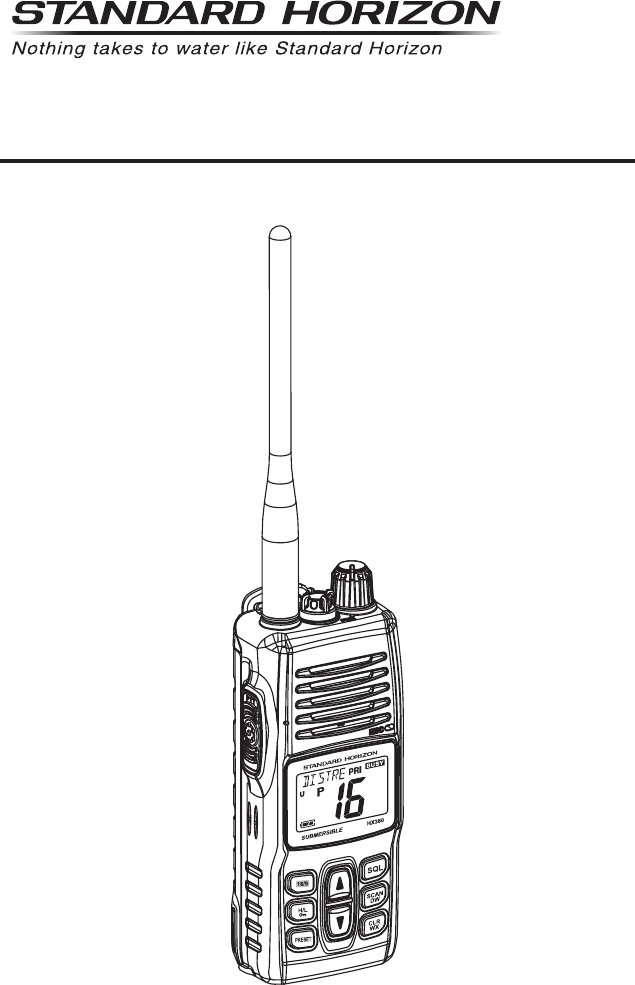
HX380
VHF FM Marine Transceiver
Owner’s Manual
Application for FCC/IC
FCC ID: K6630393X20
IC: 511B-30393X20

HX380Page 2
TABLE OF CONTENTS
WARNING! FCC RF EXPOSURE REQUIREMENTS ..................................................................... 4
1. GENERAL INFORMATION ......................................................................................................... 6
1.1 INTRODUCTION ................................................................................................................. 6
1.2 RF EXPOSURE SAFETY STATEMENT ............................................................................. 6
2. ACCESSORIES .......................................................................................................................... 7
2.1 PACKING LIST .................................................................................................................... 7
2.2 OPTIONS ............................................................................................................................ 7
3. ABOUT THIS RADIO .................................................................................................................. 8
3.1 ABOUT THE VHF MARINE BAND ...................................................................................... 8
3.2 ABOUT THE LMR CHANNELS ........................................................................................... 8
3.3 ABOUT WATER RESISTANCE ........................................................................................... 8
3.4 EMERGENCY (CHANNEL 16 USE) ................................................................................... 8
3.5 CALLING ANOTHER VESSEL (CHANNEL 16 OR 9) ......................................................... 9
3.6 OPERATING ON CHANNEL 13 ........................................................................................ 10
3.7 OPERATING ON CHANNEL 67 ........................................................................................ 10
3.8 SIMPLEX/DUPLEX CHANNEL USE ................................................................................. 10
4. GETTING STARTED ................................................................................................................. 12
4.1 RADIO CARE .................................................................................................................... 12
4.2 BELT CLIP INSTALLATION AND REMOVAL .................................................................... 12
4.3 BATTERIES AND CHARGERS ......................................................................................... 13
4.3.1 BATTERY SAFETY .................................................................................................. 13
4.3.2 BATTERY INSTALLATION AND REMOVAL ............................................................ 14
4.3.3 BATTERY CHARGING ............................................................................................ 15
5. CONTROLS AND INDICATORS ............................................................................................... 16
5.1 CONTROLS AND SWITCHES .......................................................................................... 16
5.2 LCD INDICATORS ............................................................................................................ 19
6. BASIC OPERATION ................................................................................................................. 20
6.1 INITIAL SETUP ................................................................................................................. 20
6.2 RECEPTION ..................................................................................................................... 20
6.3 TRANSMISSION ............................................................................................................... 20
6.3.1 TRANSMIT TIME - OUT TIMER (TOT) .................................................................... 21
6.4 USA, CANADIAN, AND INTERNATIONAL CHANNELS ................................................... 21
6.5 NOAA WEATHER CHANNELS ......................................................................................... 22
6.5.1 NOAA WEATHER ALERT ........................................................................................ 22
6.5.2 NOAA WEATHER ALERT TESTING ....................................................................... 22
6.6 KEYPAD LOCKING ........................................................................................................... 23
6.7 PRESET CHANNELS (0 ~ 9): INSTANT ACCESS ........................................................... 23
6.7.1 PROGRAMMING ..................................................................................................... 23
6.7.2 OPERATION ............................................................................................................ 23
6.8 MEMORY SCAN ............................................................................................................... 24
6.8.1 PROGRAMMING SCAN MEMORY ......................................................................... 24
6.8.2 OPERATION ............................................................................................................ 24
6.9 PRIORITY SCAN .............................................................................................................. 25
6.10 DUAL WATCH ................................................................................................................. 26
6.11 TRI-WATCH ..................................................................................................................... 26
7. MENU (“SET”) MODE .............................................................................................................. 27
8. MAINTENANCE ........................................................................................................................ 30
8.1 GENERAL ......................................................................................................................... 30
8.2 REPLACEMENT PARTS ................................................................................................... 30
8.3 FACTORY SERVICE ......................................................................................................... 31
8.4 TROUBLESHOOTING CHART ......................................................................................... 31
9. VHF MARINE CHANNEL ASSIGNMENTS .............................................................................. 32
10. WARRANTY ............................................................................................................................ 36
ON-LINE WARRANTY REGISTRATION ................................................................................ 38
11. INSTALLATION OF OPTION .................................................................................................. 39
11.1 FBA-40 ALKALINE BATTERY TRAY ............................................................................... 39
12. SPECIFICATIONS ................................................................................................................... 40
12.1 GENERAL ....................................................................................................................... 40
12.2 TRANSMITTER ............................................................................................................... 40
12.3 RECEIVER ...................................................................................................................... 41
FCC AND CANADA RADIO LICENSE INFORMATION ................................................................ 42
Application for FCC/IC
FCC ID: K6630393X20
IC: 511B-30393X20
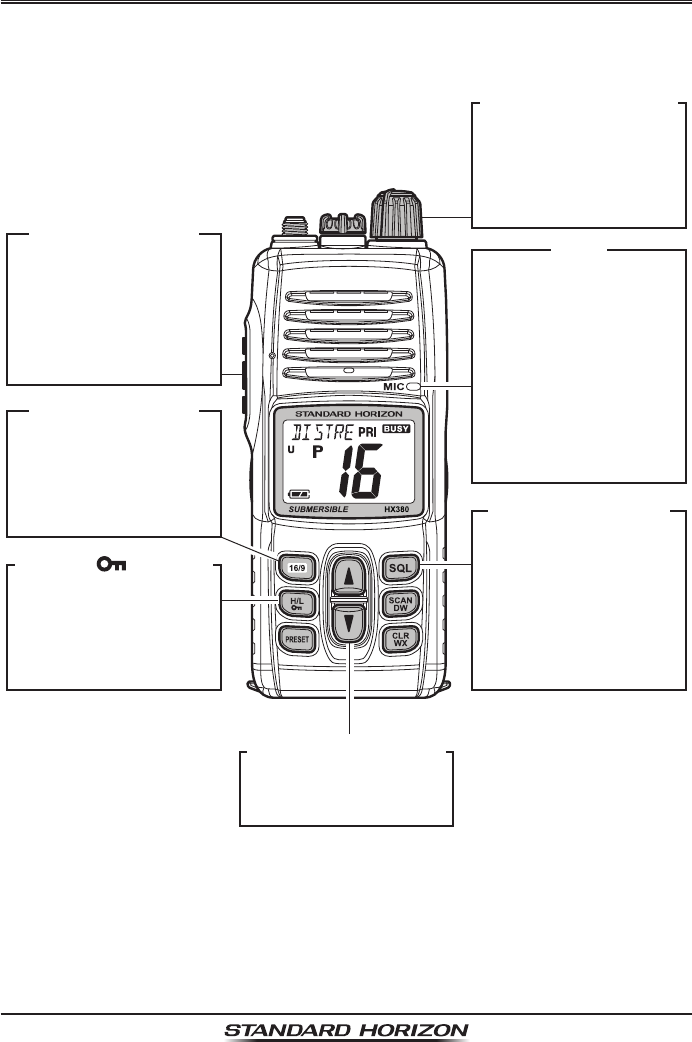
Page 3HX380
Quick RefeRence Guide
This transceiver is equipped with the E2O (Easy-To-Operate) system. You can
do the basic operation in numerical order of the illustration below.
[PWR/VOL] Knob
Rotate this knob
clockwise to turn on
the radio, and adjust
the audio level.
[SQL] Button
Press this key first,
then press the []
key to squelch or
press the [] key
to un-squelch the
radio.
[]/[] Buttons
Selects the operat-
ing channel.
MIC
When transmitting,
position your mouth
1 inch (2.5 cm)
away from the small
mic hole.
Speak slowly and
clearly into the mi-
crophone.
[16/9] Button
Press to recall
channel 16.
Press and hold to
recall channel 9.
[H/L()] Button
Press to toggle the
transmit power be-
tween High (5W)
and Low (1W).
[PTT] Switch
Speak into the
micro-phone in a
normal voice level
while pressing this
switch.
Application for FCC/IC
FCC ID: K6630393X20
IC: 511B-30393X20
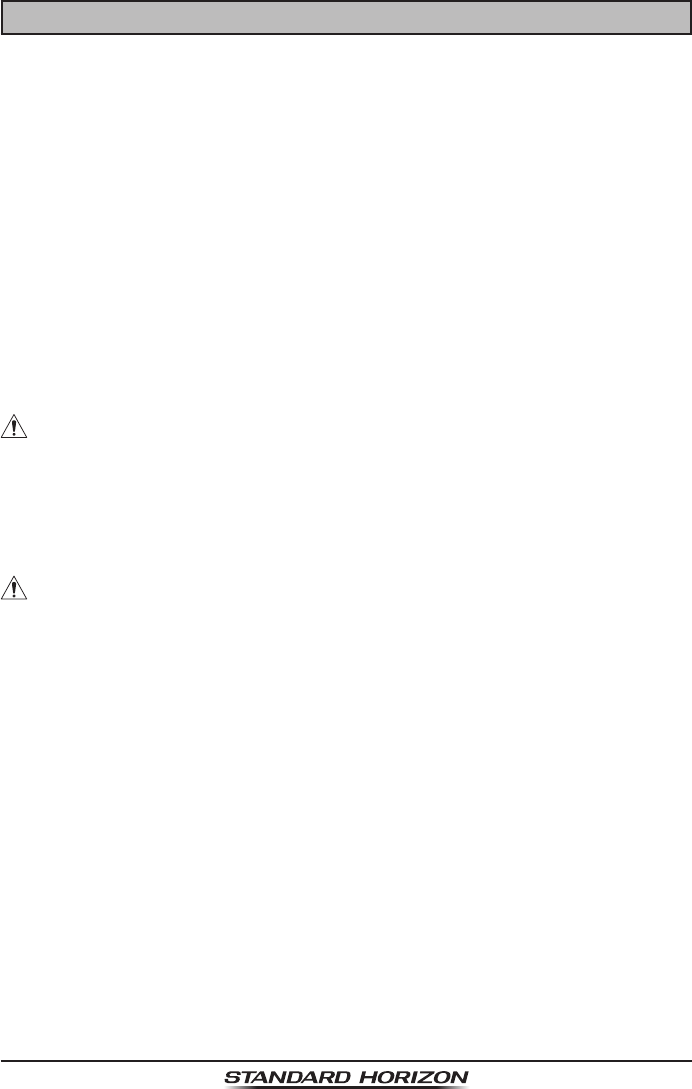
HX380Page 4
WARNING! FCC RF EXPOSURE REQUIREMENTS
This Radio has been tested and complies with the Federal Communications
Commission (FCC) RF exposure limits for Occupational Use/Controlled ex-
posure environment. In addition, it complies with the following Standards and
Guidelines:
FCC 96-326, Guidelines for Evaluating the Environmental Effects of Ra-
dio-Frequency Radiation.
FCC OET Bulletin 65 Edition 97-01 (2001) Supplement C, Evaluating Com-
pliance with FCC Guidelines for Human Exposure to Radio Frequency
Electromagnetic Fields.
ANSI/IEEE C95.1-1992, IEEE Standard for Safety Levels with Respect to
Human Exposure to Radio Frequency Electromagnetic Fields, 3 kHz to 300
GHz.
ANSI/IEEE C95.3-1992, IEEE Recommended Practice for the Measure-
ment of Potentially Hazardous Electromagnetic Fields - RF and Microwave.
WARNING:
This radio generates RF electromagnetic energy during transmit mode. This
radio is designed for and classied as Occupational Use Only, meaning it
must be used only during the course of employment by individuals aware of
the hazards, and the ways to minimize such hazards. This radio is not intend-
ed for use by the General Population in an uncontrolled environment.
CAUTION:
To ensure that your expose to RF electromagnetic energy is within the FCC al-
lowable limits for occupational use, always adhere to the following guidelines:
This radio is NOT approved for use by the general population in an uncon-
trolled exposure environment. This radio is restricted to occupational use,
work related operations only where the radio operator must have the knowl-
edge to control his or her RF exposure conditions.
When transmitting, hold the radio in a vertical position with its microphone 1
inche (2.5 cm) away from your mouth and keep the antenna at least 1 inch-
es (2.5 cm) away from your head and body.
The radio must be used with a maximum operating duty cycle not exceed-
ing 50%, in typical Push-to-Talk congurations.
DO NOT transmit for more than 50% of total radio use time (50% duty cy-
cle). Transmitting more than 50% of the time can cause FCC RF exposure
compliance requirements to be exceeded.
SAR compliance for body-worn use was only demonstrated for the specif-
ic belt-clip (CLIP-
920).
Other body-worn accessories or congurations may
NOT comply with the FCC RF exposure requirements and should be avoided.
Application for FCC/IC
FCC ID: K6630393X20
IC: 511B-30393X20

Page 5HX380
The CLIP-920 belt-clip must be used in order to comply with the FCC/IC RF
exposure requirements.
Always use Standard Horizon authorized accessories.
The information listed above provides the user with the information needed
to make him or her aware of RF exposure, and what to do to assure that
this radio operates with the FCC RF exposure limits of this radio.
Electromagnetic Interference/Compatibility
During transmissions, this radio generates RF energy that can possibly
cause interference with other devices or systems. To avoid such interfer-
ence, turn off the radio in areas where signs are posted to do so.
Do not operate the transmitter in areas that are sensitive to electromagnetic
radiation such as hospitals, health care facilities, aircraft, and blasting sites.
Application for FCC/IC
FCC ID: K6630393X20
IC: 511B-30393X20
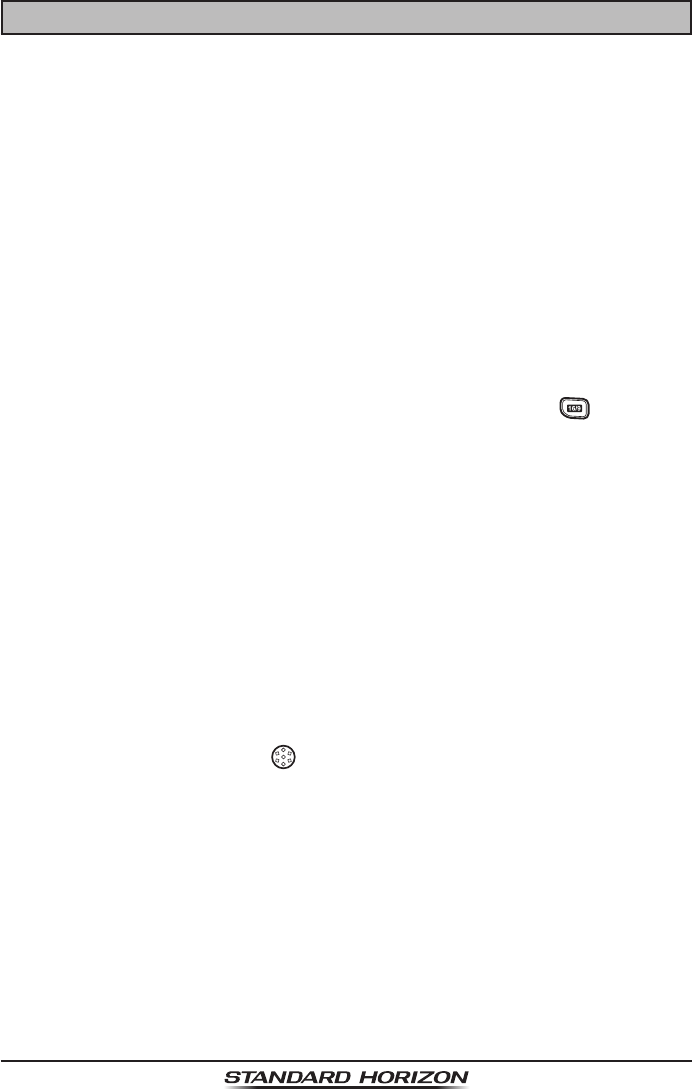
HX380Page 6
1. GENERAL INFORMATION
1.1 INTRODUCTION
Congratulations on your purchase of the HX380! Whether this is your first
portable marine VHF transceiver, or if you have other STANDARD HORIZON
equipment, the STANDARD HORIZON organization is committed to ensuring
your enjoyment of this high performance transceiver, which should provide
you with many years of satisfying communications even in the harshest of
environments. STANDARD HORIZON technical support personnel stands
behind every product sold, and we invite you to contact us should you require
technical advice or assistance.
The HX380 is a Submersible 5-Watt portable two way marine transceiver with
the capability to be programmed with 40 LMR (Land Mobile Radio) channels
with CTCSS or DCS signalling by a dealer. The transceiver has all allocated
International, Canadian, or USA channels. It has emergency channel 16 which
can be immediately selected from any channel by pressing the key.
The HX380 includes the following features: 10 PRESET channels for enabling
the instant access, Memory Scanning, Priority Scanning, Battery Saver, easy-
to-read large LCD display, EEPROM memory back-up, Battery Life displayed
on the LCD, and a transmit Time-Out Timer (TOT).
The HX380 transmitter provides a full 5 Watt of transmit power and also is se-
lectable to 1 Watt to assist the user in ensuring maximum battery life.
We appreciate your purchase of the HX380, and encourage you to read this
manual thoroughly, so as to learn and fully understand the capabilities of the
HX380.
1.2 RF EXPOSURE SAFETY STATEMENT
Your wireless handheld portable transceiver contains a low power transmitter.
When the Push-To-Talk (PTT: ) button is pushed, the transceiver sends out
radio frequency (RF) signals.
This device is authorized to operate at a duty factor not to exceed 50% (this
corresponds to 50% transmission time and 50% reception time).
This transmitter and its antenna must maintain a separation distance of at
least 1 inch (2.5 cm) from your face. Speak in a normal voice, with the anten-
na pointed up and away from the face at the required separation distance.
Use only the supplied antenna. Unauthorized antennas, modications, or at-
tachments could damage the transmitter.
Application for FCC/IC
FCC ID: K6630393X20
IC: 511B-30393X20
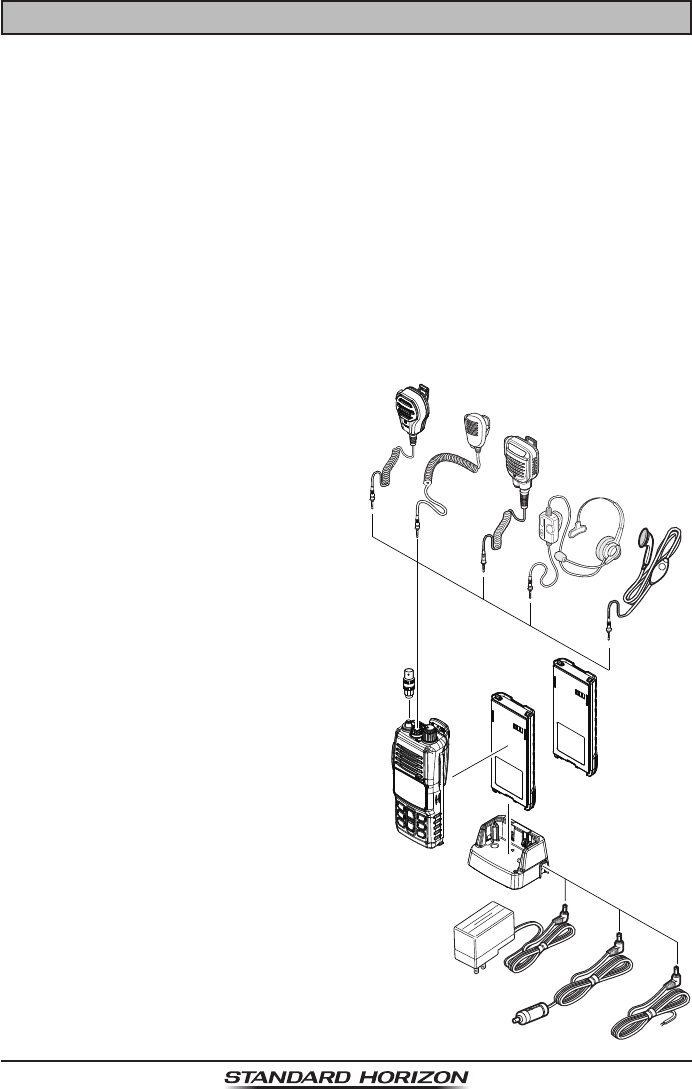
Page 7HX380
2. ACCESSORIES
2.1 PACKING LIST
When the package containing the transceiver is rst opened, please check it
for the following contents:
HX380 Transceiver
CAT460 Antenna
FNB-V105LI 7.4 V Li-Ion Battery Pack
CD-48 Charger Cradle for HX380
SAD-11B 120VAC Wall Charger for CD-48
E-DC-19 DC Cable with 12 V Cigarette Lighter Plug
Belt Clip
Owner’s Manual
2.2 OPTIONS
① MH-73A4B Speaker/Microphone
② MH-57A4B Mini Speaker/Micro-
phone
③ SSM-14A Submersible Speaker/
Microphone
④ SSM-64A VOX Headset
⑤ SSM-55A Earpiece/Microphone
⑥ CN-3 Radio-to-Ship’s An-
tenna Adapter
⑦ CD-48 Charger Cradle
⑧ FNB-V105LI 7.4 V Li-Ion Battery
Pack
⑨ FBA-40 Alkaline Battery Case
⑩ SAD-11B AC Wall Charger for
the FNB-V105LI
⑪ E-DC-19A DC Cable with 12 V
Cigarette Lighter Plug
⑫ E-DC-6 DC Cable; plug and
wire only
Note: Before operating the HX380 for
the first time, it is recommended that
the battery be charged. Please see
section “4.3.3 BATTERY CHARGING”
for details. ⑪
①
②
③
④
⑤
⑥
⑦
⑧
⑨
⑩
⑫
Application for FCC/IC
FCC ID: K6630393X20
IC: 511B-30393X20

HX380Page 8
3. ABOUT THIS RADIO
3.1 ABOUT THE VHF MARINE BAND
The radio frequencies used in the VHF marine band lie between 156 and 162
MHz. The marine VHF band provides communications over distances that
are essentially “Line of sight” Actual transmission range depends much more
on antenna type, gain and height than on the power output of the transmitter.
On a xed mount 25 W radio transmission expected distances can be greater
than 15 miles, for a portable 5 W radio transmission the expected distance
can be greater than 5 miles in “Line of sight”.
The user of a Marine VHF radio is subject to severe nes if the radio is used
on land. The reasoning for this is you may be near an inland waterway, or
propagation anomalies may cause your transmission to be heard in a water-
way. If this occurs, depending upon the marine VHF channel on which you are
transmitting, you could interfere with a search and rescue case, or contribute
to a collision between passing ships. For VHF Marine channel assignments
refer to page 32 section 9.
3.2 ABOUT THE LMR CHANNELS
The HX380 is capable of being programmed with 40 LMR (Land Mobile Ra-
dio) channels by a dealer. The frequency range is 134 to 174MHz which may
be setup for 25 kHz (wide) or 12.5 kHz (narrow) channel stepping with CTCSS
and DCS signaling. Contact your dealer for further details.
3.3 ABOUT WATER RESISTANCE
Water resistance of the transceiver is ensured only when the battery pack is
attached to the transceiver and MIC/SP cap is installed in the MIC/SP jack.
3.4 EMERGENCY (CHANNEL 16 USE)
Channel 16 is known as the Hail and Distress Channel. An emergency may be
dened as a threat to life or property. In such instances, be sure the transceiv-
er is on and set to “Channel 16”. Then use the following procedure:
1. Press the PTT (Push-To-Talk: ) switch and say “Mayday, Mayday, May-
day. This is _____, _____, _____” (your vessel’s name).
2. Then repeat once: “Mayday, _____” (your vessel’s name).
3. Now report your position in latitude/longitude, or by giving a true or magnet-
ic bearing (state which) to a well-known landmark such as a navigation aid
or geographic feature such as an island or harbor entry.
4. Explain the nature of your distress (sinking, collision, aground, re, heart
attack, life-threatening injury, etc.).
5. State the kind of assistance your desire (pumps, medical aid, etc.).
6. Report the number of persons aboard and condition of any injured.
Application for FCC/IC
FCC ID: K6630393X20
IC: 511B-30393X20

Page 9HX380
7. Estimate the present seaworthiness and condition of your vessel.
8. Give your vessel’s description: length, design (power or sail), color and oth-
er distinguishing marks. The total transmission should not exceed 1 minute.
9. End the message by saying “OVER”. Release the PTT ( ) switch and lis-
ten.
10. If there is no answer, repeat the above procedure. If there is still no re-
sponse, try another channel.
3.5 CALLING ANOTHER VESSEL (CHANNEL 16 OR 9)
Channel 16 may be used for initial contact (hailing) with another vessel.
However, its most important use is for emergency messages. This channel
must be monitored at all times except when actually using another channel.
It is monitored by the U.S. and Canadian Coast Guards and by other vessels.
Use of channel 16 for hailing must be limited to initial contact only. Calling
should not exceed 30 seconds, but may be repeated 3 times at 2-minute in-
tervals. In areas of heavy radio traffic, congestion on channel 16 resulting
from its use as a hailing channel can be reduced signicantly in U.S. waters
by using Channel 9 as the initial contact (hailing) channel for non-emergency
communications. Also hailing on channel 9, the calling time should not exceed
30 seconds but may be repeated 3 times at 2-minute intervals.
Prior to making contact with another vessel, refer to the channel charts in this
manual, and select an appropriate channel for communications after initial con-
tact. For example, Channels 68 and 69 of the U.S. VHF Charts are some of the
channels available to non-commercial (recreational) boaters. Monitor your de-
sired channel in advance to make sure you will not be interrupting o
ther trafc,
and then go back to either channel 16 or 9 for your initial contact.
When the hailing channel (16 or 9) is clear, state the name of the other vessel
you wish to call and then “this is” followed by the name of your vessel and
your Station License (Call Sign). When the other vessel returns your call, im-
mediately request another channel by saying “go to”, the number of the other
channel, and “over”. Then switch to the new channel. When the new channel
is not busy, call the other vessel.
After a transmission, say “over”, and release the PTT (Push-To-Talk: )
switch. When all communication with the other vessel is completed, end the
last transmission by stating your Call Sign and the word “out”. Note that it is
not necessary to state your Call Sign with each transmission, only at the be-
ginning and end of the contact.
Remember to return to Channel 16 when not using another channel.
Application for FCC/IC
FCC ID: K6630393X20
IC: 511B-30393X20

HX380Page 10
3.6 OPERATING ON CHANNEL 13
Channel 13 is used at docks, bridges and for maneuvering in port. Messages
on this channel must concern navigation only, such as meeting and passing
in restricted waters. In emergencies and when approaching blind river bends,
High power is allowed. Pressing the key will change the power output
from Low Power (1 Watt) to High (5 Watts). When you change from this chan-
nel then return to it, low power will be automatically selected.
3.7 OPERATING ON CHANNEL 67
When channel 67 is used for navigational bridge-to-bridge traffic between
ships, High power may be used temporarily (in the USA band) by pressing the
key. When release the PTT switch, the transceiver will revert to low pow-
er.
3.8 SIMPLEX/DUPLEX CHANNEL USE
Refer to the VHF MARINE CHANNEL CHART (page 32) for instructions on
use of simplex and duplex channels.
NOTE
All channels are factory-programmed in accordance with FCC, Industry
Canada, and International regulations. The mode of operation cannot be
altered from simplex to duplex or vice-versa. Simplex (ship to ship) or du-
plex (marine operator) mode is automatically activated, depending on the
channel and whether the USA, Canadian or International operating band
is selected.
Application for FCC/IC
FCC ID: K6630393X20
IC: 511B-30393X20

Page 11HX380
MEMO
Application for FCC/IC
FCC ID: K6630393X20
IC: 511B-30393X20
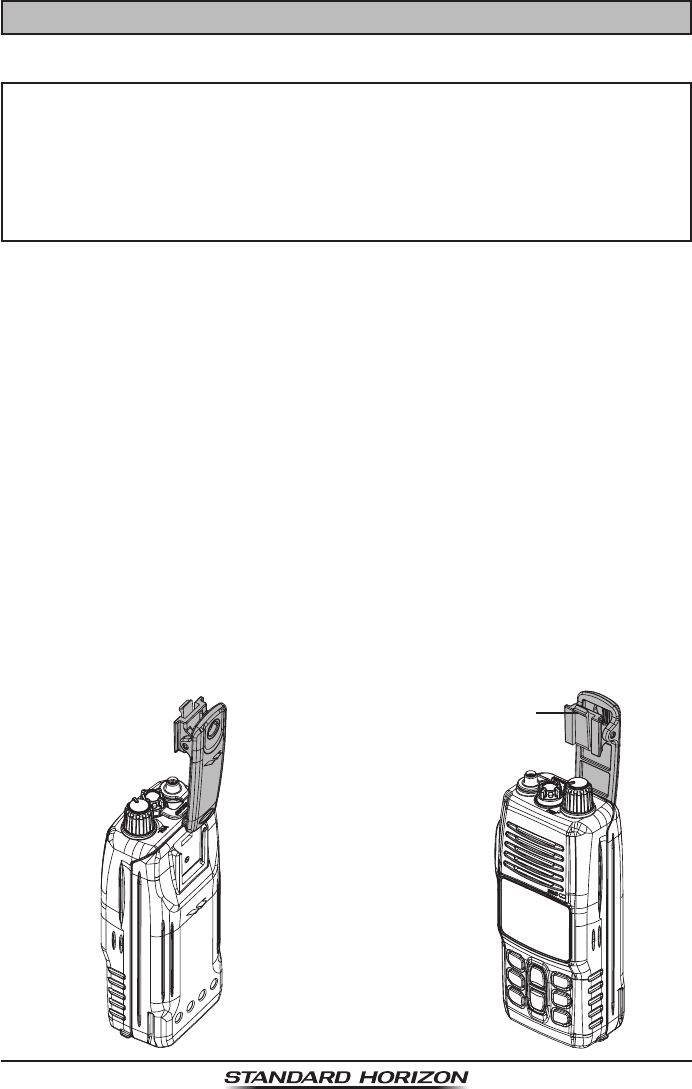
HX380Page 12
4. GETTING STARTED
4.1 RADIO CARE
CAUTION
Before following the instructions below, insure the battery pack is in place
and rmly connected. Care must be taken if the radio was dropped and a
close inspection may be needed to insure the radio case and gaskets are
in adequate condition.
The design of the HX380 allows water to enter between the radio and the bat-
tery pack, however waterproof performance is not compromised.
After using the HX380 in salt water environment is recommended to clean the
radio with fresh water by rinsing the battery and radio (separately) under a
sink facet or by dunking in a fresh water. After washing,use a soft cloth to thor-
oughly dry all parts of the radio and battery.
This will keep the radio parts and the battery clean and in top operating condi-
tion.
4.2 BELT CLIP INSTALLATION AND REMOVAL
To install the Belt Clip: align the
Belt Clip to the groove of the Bat-
tery pack, then press the Belt Clip
downward until it locks in place
with a “Click.”
To remove the Belt Clip: press the
Belt Clip Tab away from the bat-
tery pack to unlock the Belt Clip,
then slide the Belt Clip upward to
remove it.
Belt Clip Tab
Application for FCC/IC
FCC ID: K6630393X20
IC: 511B-30393X20

Page 13HX380
4.3 BATTERIES AND CHARGERS
If the radio has never been used, or its charge is depleted, it may be
charged by connecting the CD-48 Charger Cradle with the SAD-11B Battery
Charger, as shown in the illustration. If 12V DC power is available, the sup-
plied E-DC-19A DC Cable with 12 V Cigarette Lighter Plug may be used for
charging the battery. The SAD-11B and E-DC-19A will charge a completely
discharged FNB-V105LI battery pack in approximately 3 hours.
The FNB-V105LI is a high performance Li-Ion battery providing high capacity
in a compact package.
CAUTION
To avoid risk of explosion and injury, FNB-V105LI battery pack should
only be removed, charged or recharged in non-hazardous environments.
4.3.1 BATTERY SAFETY
Battery packs for your transceiver contain Li-Ion batteries. This type of bat-
tery stores a charge powerful enough to be dangerous if misused or abused,
especially when removed from the transceiver. Please observe the following
precautions:
DO NOT SHORT BATTERY PACK TERMINALS: Shorting the terminals that
power the transceiver can cause sparks, severe overheating, burns, and bat-
tery cell damage. If the short is of sufcient duration, it is possible to melt bat-
tery components. Do not place a loose battery pack on or near metal surfaces
or objects such as paper clips, keys, tools, etc. When the battery pack is in-
stalled on the transceiver, the terminals that transfer current to the transceiver
are not exposed. The terminals that are exposed on the battery pack when it
is mounted on the transceiver are charging terminals only and do not consti-
tute a hazard.
DO NOT INCINERATE: Do not dispose of any battery in a re or incinerator.
The heat of re may cause battery cells to explode and/or release dangerous
gases.
Battery Maintenance
For safe and proper battery use, please observe the following:
Battery packs should be charged only in non-hazardous environments;
Use only STANDARD HORIZON-approved batteries;
Use only a STANDARD HORIZON approved charger. The use of any other
charger may cause permanent damage to the battery.
Follow charging instructions provided with the chargers.
Keep the battery contacts clean and dry.
Application for FCC/IC
FCC ID: K6630393X20
IC: 511B-30393X20

HX380Page 14
Battery Storage
Store the batteries in a cool place to maximize storage life. Since batteries are
subject to self-discharge, avoid high storage temperatures that cause large
self-discharge rates. After extended storage, a full recharge is recommended.
Battery Recycling
DO NOT PLACE USED BATTERIES IN YOUR REGULAR TRASH!
LI-ION BATTERIES MUST BE COLLECTED, RECYCLED OR DISPOSED
OF IN AN ENVIRONMENTALLY SOUND MANNER.
The incineration, land lling or mixing of Li-Ion batteries with the municipal sol-
id waste stream is PROHIBITED BY LAW in most areas.
Return batteries to an approved Li-Ion battery recycler. This may be where
you purchased the battery.
Contact your local waste management ofcials for other information regarding
the environmentally sound collection, recycling and disposal of Li-Ion batter-
ies.
4.3.2 BATTERY INSTALLATION AND REMOVAL
To install the battery pack, hold the trans-
ceiver with your left hand, so your palm is
over the speaker. Insert the battery pack
into the battery compartment on the back
of the radio, then push the bottom side
of the battery pack until the battery pack
locks with the Battery Pack Latch.
To remove the battery, turn the radio off. Slide the Battery Pack Latch on
the bottom of the radio, then lift up on the bottom of the battery and remove
it from the radio.
Application for FCC/IC
FCC ID: K6630393X20
IC: 511B-30393X20
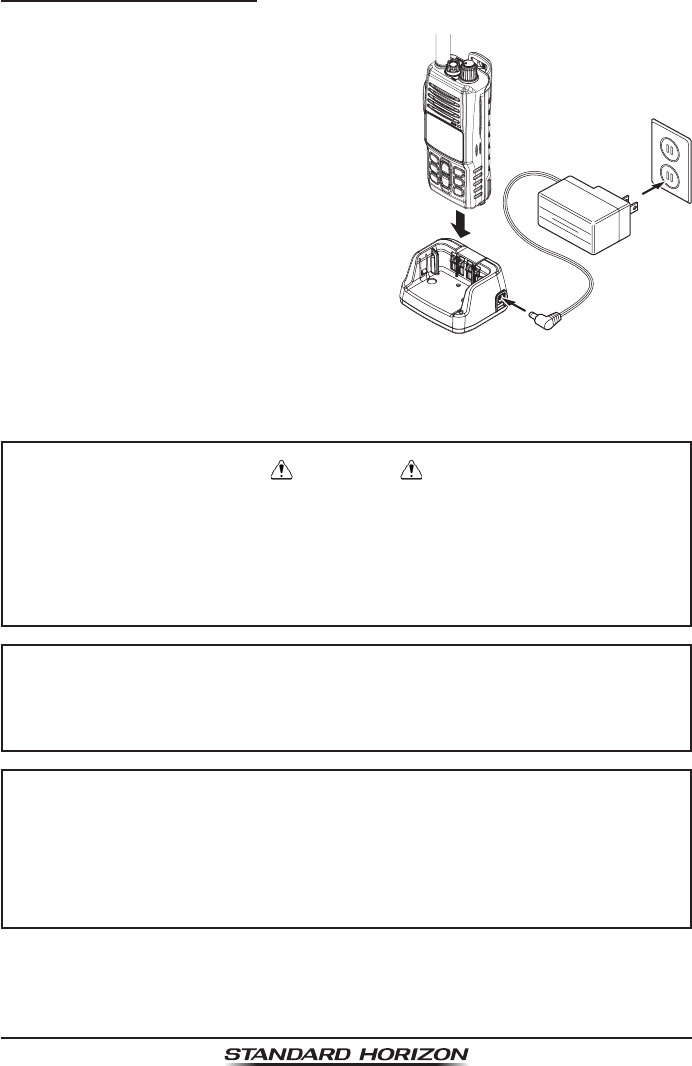
Page 15HX380
4.3.3 BATTERY CHARGING
1. Turn the transceiver off.
2. Insert the DC plug from the SAD-11B
into the DC jack on the CD-48 side pan-
el, then plug the SAD-11B into the AC
line outlet.
3. Insert the HX380 (with the battery pack)
into the CD-48; the antenna should be
at the left side when viewing the char-
ger from the front.
4. If the HX380 is inserted correctly, the
Red “CHARGING” indicator will glow.
A fully-discharged pack will be charged
completely in approximately 7 hours.
5. When charging is completed, the red
LED indicator will change to green. Remove the transceiver from the CD-
48, and unplug the SAD-11B from the AC line outlet.
WARNING
Do not reverse-connect the battery terminals.
Do not parallel-connect the battery terminals.
Do not change batteries in hazardous locations.
To reduce the risk of explosion, recharge the batteries outside of
hazardous locations.
CAUTION
The CD-48 cradle is NOT designed to be waterproof. Do not attempt to
charge in water hazardous locations.
NOTE
The CD-48 cradle is only designed for the charging of the HX380’s battery,
and is not suitable for other purposes. The CD-48 may contribute noise to
TV and radio reception in the immediate vicinity, so we do not recommend
its use adjacent to such device.
SAD-11B
CD-48
Application for FCC/IC
FCC ID: K6630393X20
IC: 511B-30393X20
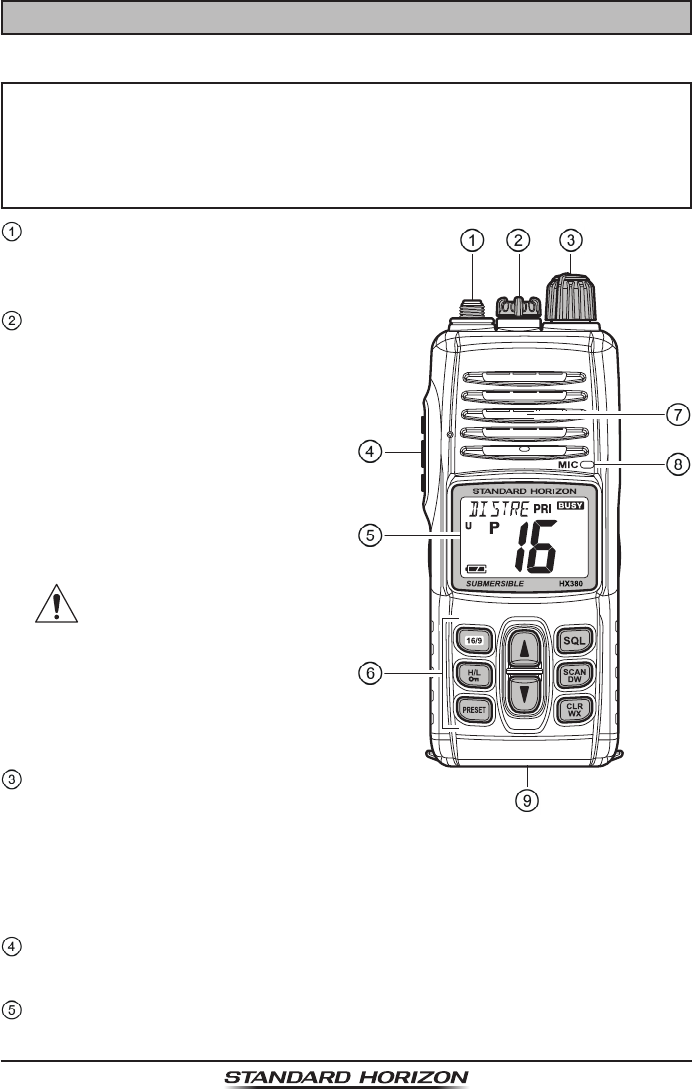
HX380Page 16
5. CONTROLS AND INDICATORS
5.1 CONTROLS AND SWITCHES
NOTE
This section denes each control of the transceiver. For detailed operating
instructions, refer to section “6. BASIC OPERATION”. Refer to illustra-
tions for the location of the following controls, switches, and connections.
ANT Jack (Top Panel)
The supplied CAT460 flexible an-
tenna is attached here.
MIC/SP Jack (Top Panel)
The jack accepts the optional SSM-
14A Submersible Speaker/Micro-
phone, MH-73A4B Speaker/Micro-
phone, MH-57A4B Mini Speaker/Mi-
crophone, SSM-64A VOX Headset,
or SSM-55A Earpiece/Microphone.
When this jack is used, the internal
speaker and microphone are dis-
abled.
1) Do not allow the HX380
to become submerged
in water while the plastic cover
over the MIC/SP jack is removed.
2) Do not remove/install the op-
tional Speaker Microphone in a
hazardous location.
POWER Switch / VOLUME Con-
trol (VOL)
Turns the transceiver on and off as well as adjusts the audio volume level.
Turn this knob clockwise to turn the radio on and increase the speakers au-
dio volume.
Turn fully counter-clockwise to turn the radio off.
PTT (PUSH-TO-TALK) Switch
When pushed activates the transmitter.
LCD Display
This display shows current operating conditions. Refer to page 19 for details.
Application for FCC/IC
FCC ID: K6630393X20
IC: 511B-30393X20
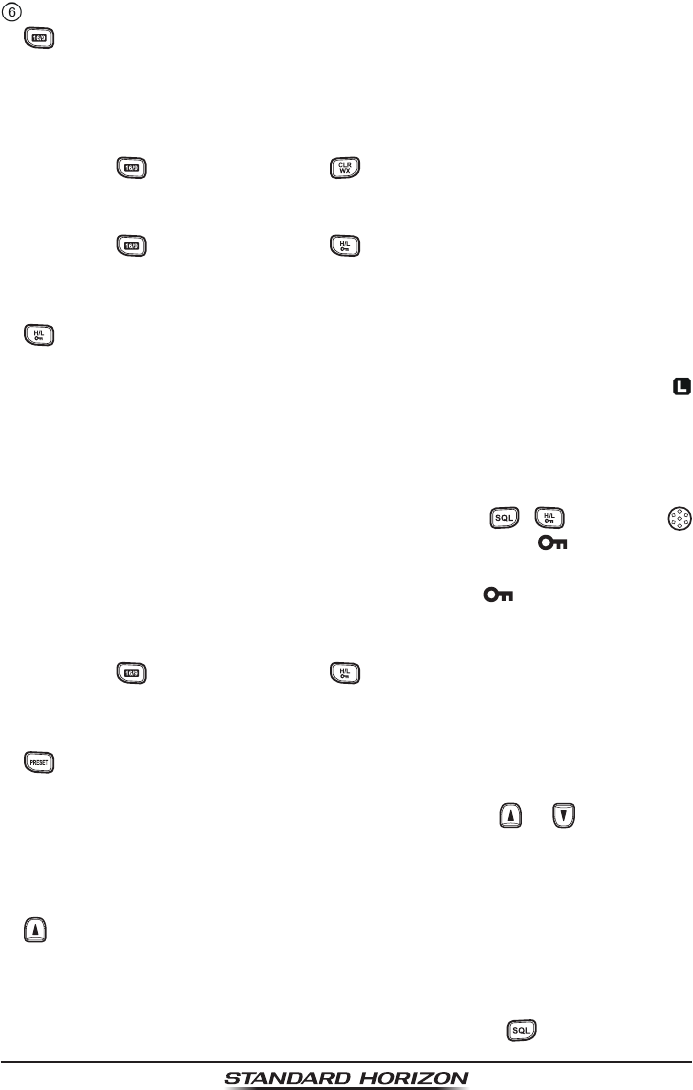
Page 17HX380
Keypad
Key
Pressing this key immediately recalls channel 16 from any channel location.
Holding down this key recalls channel 9. Pressing this key again reverts to
the previous selected working channel.
Secondary use:
When the key is held and the key is pressed, the radio will change
the marine band between the International, Canadian, and USA channels.
Advanced use:
When the key is held and the key is pressed, the radio will change
the priority channel between the Channel 16, Channel 9, and the Preset
Channel.
Key
Press this key to toggle the transmitter output power between “High” (5
Watts) and “Low” (1 Watt) power. When the “Low” power is selected, the “
” icon will appear to the right of the channel indication on the display. This
key does not function on the “Transmission Inhibited” and “Low power only”
channels.
Secondary use:
Hold down this key to lock the keypad (except the , and PTT (
) keys) so that they are not accidentally changed. The “ ” icon will ap-
pear at the right of the channel indication on the display, to indicate that the
functions are locked. Hold down this key until the “ ” icon disappears to
unlock the radio.
Advanced use:
When the key is held and the key is pressed, the radio will change
the priority channel between the Channel 16, Channel 9, and the Preset
Channel.
Key
Press this key to recall the user preset memory channels (shown as memo-
ry channel number “0” - “9” on the display). Press the or key to select
the desired preset channel.
Press and hold this key for two seconds to memorize the selected channel
into the preset memory.
Key
Press the key momentarily to increase the channel one step. Hold the key
down to increase the channel continuously.
Secondary use:
Used to adjust the squelch threshold level up after the key is pressed.
Application for FCC/IC
FCC ID: K6630393X20
IC: 511B-30393X20
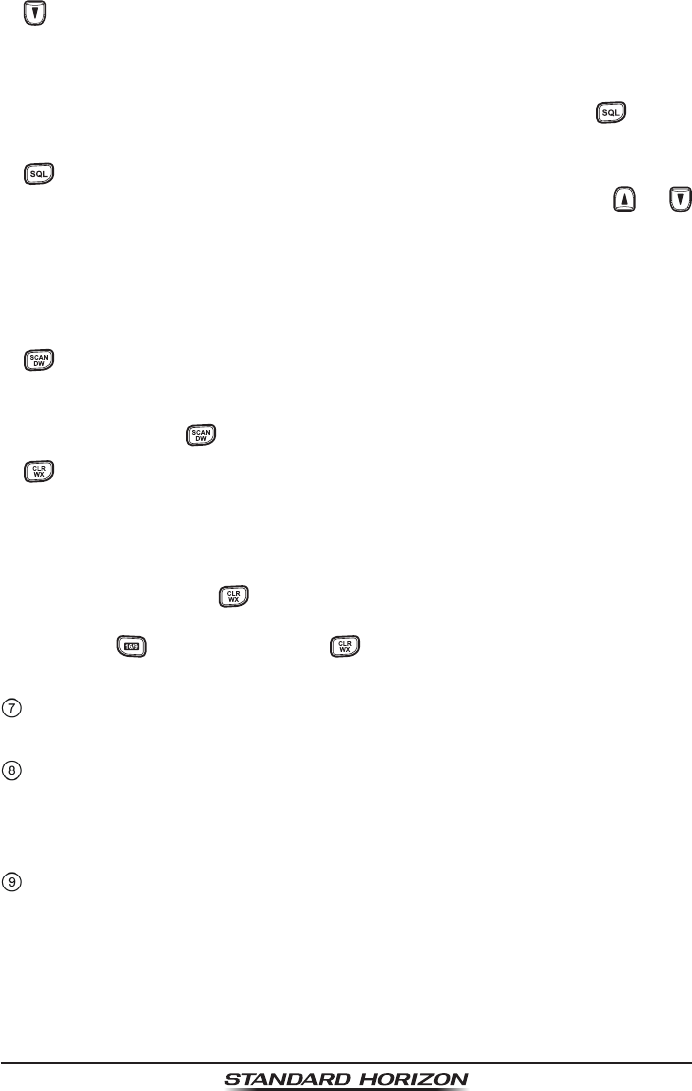
HX380Page 18
Key
Press the key momentarily to decrease the channel one step. Hold the key
down to decrease the channel continuously.
Secondary use:
Used to adjust the squelch threshold level down after the key is
pressed.
Key
Press this key to activate the squelch adjusting mode. Press the or
key to adjust the squelch threshold level.
Secondary use:
Press and hold this key for two seconds to open the squelch, allowing you
to monitor the operating channel. Release the key to resume normal (quiet)
monitoring.
Key
Starts scanning and priority scanning of programmed channels.
Secondary use:
Press and hold the key for two seconds to activate the Dual Watch feature.
Key
Press to stop the Scan, Priority Scan, or Dual Watch feature.
Secondary use:
Press and hold this key to immediately recall the last-used NOAA Weather
Channel from any channel location. Recalls the previously- selected work-
ing channel when the key is pressed again.
Advanced use:
When the key is held and the key is pressed, the radio will change
the marine band between the USA, International, and Canadian channels.
Speaker
The internal speaker is located here.
Microphone
The internal microphone is located here.
When transmitting, position your mouth 1 inch (2.5 cm) away from the small
mic hole. Speak slowly and clearly into the microphone.
Battery Pack Lock (Bottom side)
Slide the Battery Pack Lock to the “” position for battery removal.
Application for FCC/IC
FCC ID: K6630393X20
IC: 511B-30393X20
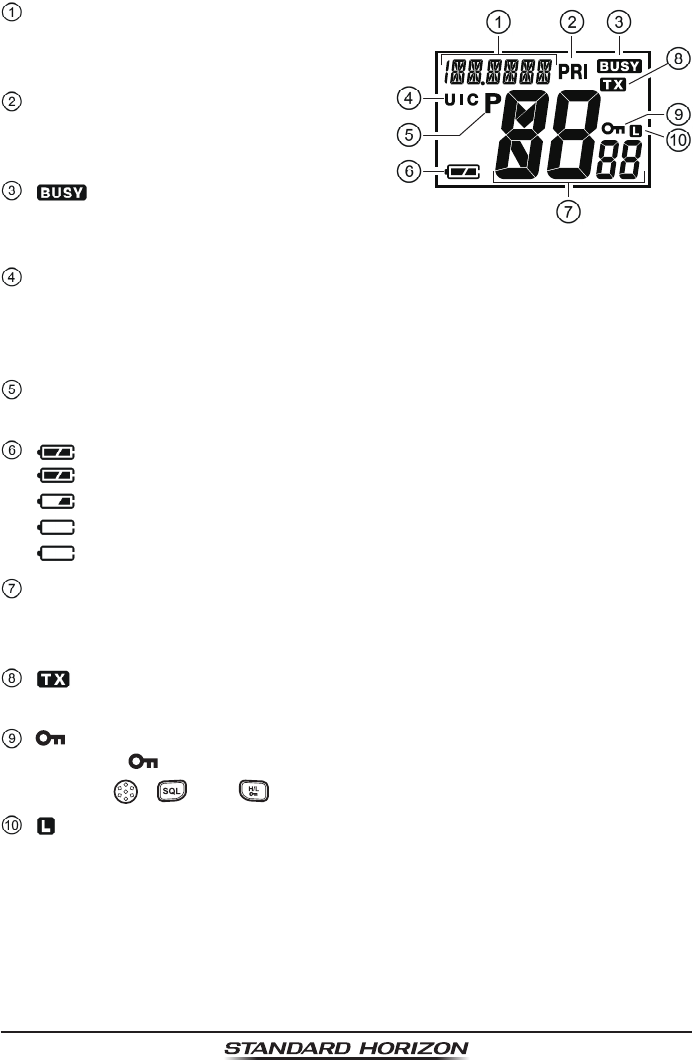
Page 19HX380
5.2 LCD INDICATORS
Alpha/numeric “Tag” display
Indicates the current channel name or
operating mode.
“PRI” Indicator
This indicator is shown when the Prior-
ity channel is selected.
“” Indicator
This indicator appears when a signal
is being received or when the radio is unsquelched.
“U/I/C” Indicator
These indicators show the “band” of operation for the particular channel. “U”
indicates the USA band; “I” indicates the International band; and “C” indi-
cates the Canadian band.
“P” Indicator
This indicator shows the channel is in the “PRESET” channel memory.
“ ” Battery Indicator
“ ”: Full battery
“ ”: Lower battery
“ ”: Battery is very low
“ (Blinking)”: Prepare to charge the battery
Channel Display
The operating channel is shown on the LCD in both the transmission and
reception modes.
“ ” Indicator
This indicator appears during transmission.
“ ” Indicator
When the “ ” icon is shown on the LCD, all keys are disabled except for
the PTT ( ), , and keys.
“ ” Indicators
This indicator shows when the TX output power is selected to “Low”
(1 Watt) power.
Application for FCC/IC
FCC ID: K6630393X20
IC: 511B-30393X20
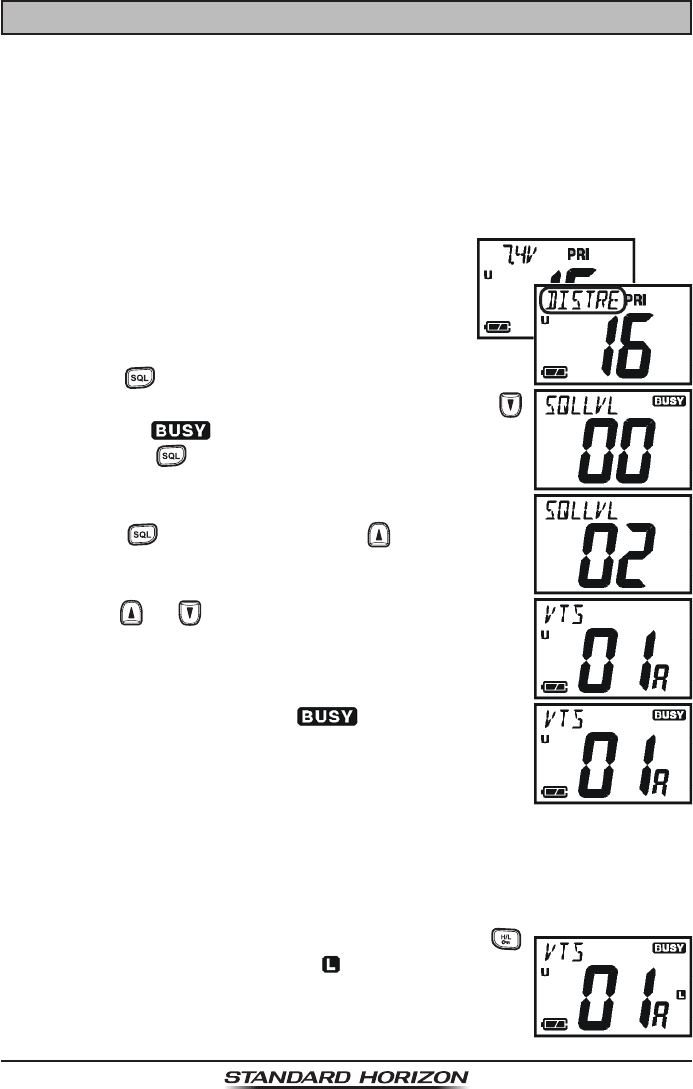
HX380Page 20
6. BASIC OPERATION
6.1 INITIAL SETUP
1. Install the battery pack on the transceiver (see section “4.3.2 BATTERY IN-
STALLATION AND REMOVAL”).
2. Install the antenna onto the transceiver; hold the bottom end of the anten-
na, then screw it onto the mating connector on the transceiver until it is
snug. Do not over-tighten.
6.2 RECEPTION
1. Turn the VOL knob clockwise to turn the trans-
ceiver on.
The battery voltage will appear briey at the upper
left corner on the display, then the channel name
will appear.
2. Press the key to activate the squelch adjusting
mode (The “SQL LVL” notation will appear). Press the
key until the “ ” indicator appears on the display,
then press the key again.
3. Turn the VOL knob clockwise until the noise or audio
from the speaker is at a comfortable level.
4. Press the key, then press the key until the
random noise disappears. This state is known as the
“Squelch Threshold”.
5. Press the or key to select the desired channel.
Refer to the channel chart on page 33 for available
channels.
6. When a signal is received, adjust the VOL knob to the
desired listening level. The “ ” indicator on the
LCD is displayed indicating that the channel is being
used.
6.3 TRANSMISSION
1. Perform “6.2 RECEPTION” discussion above.
2. Before transmitting, monitor the channel and make sure it is clear.
THIS IS AN FCC REQUIREMENT!
3. For communications over short distances, press the
key to select Low power (1 watt: “ ” icon appears).
Note: Transmitting on Low power prolongs battery life.
Low power should be selected whenever possible.
Application for FCC/IC
FCC ID: K6630393X20
IC: 511B-30393X20
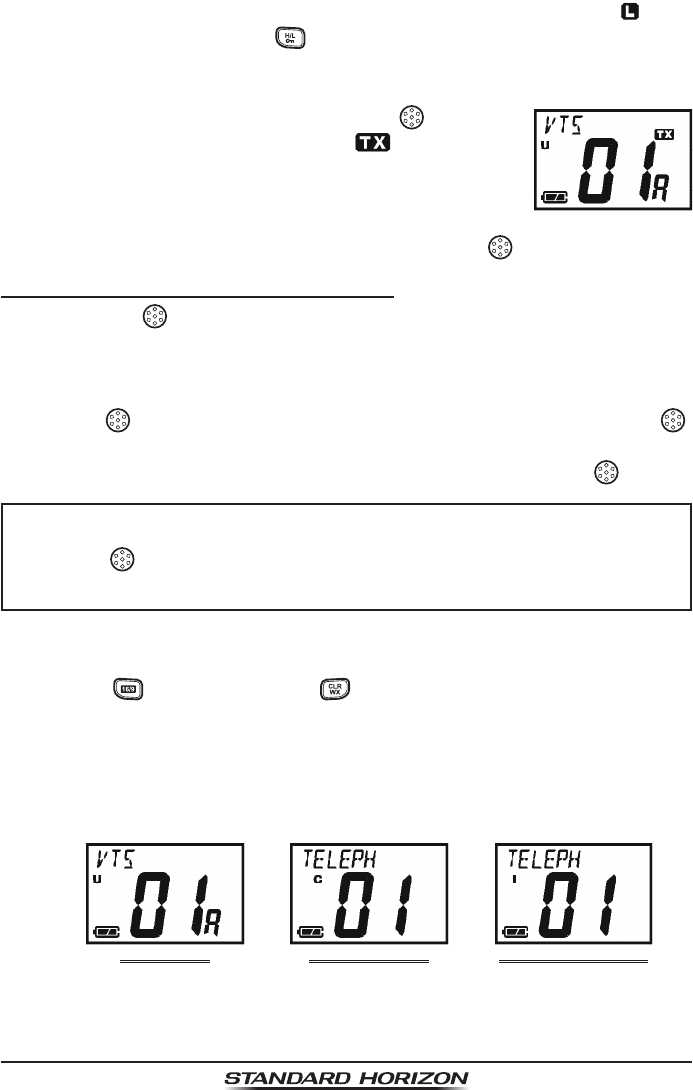
Page 21HX380
“USA” BAnd “InternAtIonAl” BAnd“CAnAdIAn” BAnd
4. If using Low power is not effective, select High power (5 watts: “ ” icon
disappears) by pressing the key.
5. When receiving a signal, wait until the incoming signal stops before trans-
mitting. The transceiver cannot transmit and receive simultaneously.
6. Press and hold the PTT (Push-To-Talk: ) switch to
transmit. During transmission, the “ ” indicator will
appear on the display.
7. Position your mouth 1 inch (2.5 cm) away from the mic
hole. Speak slowly and clearly into the microphone.
8. When the transmission is nished, release the PTT () switch.
6.3.1 TRANSMIT TIME - OUT TIMER (TOT)
While the PTT () switch is held down, transmission time is limited to 5 min-
utes. This prevents prolonged (unintentional) transmissions. About 10 seconds
before automatic transmitter shutdown, a warning beep will sound from the
speaker. The transceiver automatically switches to the receiving mode, even
if the PTT ( ) switch is held down. Before transmitting again, the PTT ( )
switch must rst be released. This Time-Out-Timer (TOT) prevents a continu-
ous transmission that would result from an accidentally stuck PTT ( ) switch.
NOTE
The PTT ( ) switch is disabled for 10 seconds after the transceiver auto-
matically switches to the receiving mode by the TOT feature.
6.4 USA, CANADIAN, AND INTERNATIONAL CHANNELS
1. To change from US to Canadian or International Marine Channels, hold
down the key and press the key. The band will change from USA,
to Canadian, and to International with each press.
2. “U” appears on the LCD for the USA band, “C” appears for the Canadian
band, and “I” appears for the International band.
3. Refer to the marine channel charts in section “9 VHF MARINE CHANNEL
ASSIGNMENTS” for allocated channels.
Application for FCC/IC
FCC ID: K6630393X20
IC: 511B-30393X20

HX380Page 22
6.5 NOAA WEATHER CHANNELS
In the event of a major storm or other appreciable weather condition requiring
vessels at sea (or other bodies of water) to be notied, the NOAA (National
Oceanographic and Atmospheric Administration) broadcasts a 1050 Hz tone
which the HX380 can detect and alert you of pending storm warnings. The
1050 Hz tone, when detected, will produce a loud beep in the speaker of the
HX380, to signal that a Weather Alert Broadcast is being received.
1. To receive a NOAA (National Oceanic and Atmospheric Administration)
weather broadcast, press and hold the key. The
transceiver changes to the weather channel mode and
recalls the last used NOAA weather channel. This mode
consists of a preset memory bank containing the NOAA
weather channels.
2. Press the or key to change to other weather channels.
3. To exit from the weather channel mode, press and hold the key. The
transceiver will revert to the channel you were using prior to switching to the
weather channel mode.
6.5.1 NOAA WEATHER ALERT
In the event of extreme weather disturbances such as storms and hurricanes,
NOAA sends a “weather alert” consisting of a 1050 Hz tone, followed by
weather reports on the weather channels.
When a “weather alert” is received on a weather channel,
the transceiver emits a beep tone. Press the key to
stop the beep tone and listen to the weather reports.
6.5.2 NOAA WEATHER ALERT TESTING
In order to test this system, NOAA broadcasts the 1050 Hz tone every
Wednesday sometime between 11 AM and 1 PM local time. You may use
this opportunity to test your HX380 periodically to conrm that the Weather
Alert feature is working, or for training crew members on how to congure the
HX380 to receive the NOAA Weather Alerts.
Application for FCC/IC
FCC ID: K6630393X20
IC: 511B-30393X20

Page 23HX380
6.6 KEYPAD LOCKING
In order to prevent accidental channel change, the HX380’s keypad may be locked.
1. Hold down the key to lock the keypad (except the
PTT (), , and keys) so that they are not acci-
dentally changed. The “ ” icon will appear next to the
channel number on the display, indicating that the func-
tions are locked.
2. Hold down the key until the “ ” icon disappears to unlock the radio.
6.7 PRESET CHANNELS (0 ~ 9): INSTANT ACCESS
Ten user assigned channels can be programmed for instant access. Pressing
the key activates the user assigned channel bank.
6.7.1 PROGRAMMING
1. Select the desired channel to be saved into the Preset
channel bank using the or key.
2. Press and hold the key until the channel number
blinks. The “P” icon and Preset channel number blink,
then release the key.
3. Press the or key to select the desired Preset
channel (“0” ~ “9”). If you see the “Underscore” between
the current channel number and the Preset channel
number, it means that the Preset channel currently has
no data written on it (i.e. the channel is “free”).
4. Press the key to program the current channel into
the Preset channel bank.
5. Repeat steps 3 and 4 to program the other channel into
the Preset Channels, if desired.
6. To delete a Preset Channel, select the Preset Channel Number to be delet-
ed using the or key, then press and hold the key until the Preset
Channel Number is removed from the display.
6.7.2 OPERATION
1. Press the key to change the transceiver to the Pre-
set channel mode. The “P” icon and Preset channel
number will appear on the display.
2. Press the or key to select the desired Preset
Channels (“0” through “9”).
3. To exit from the Preset channel mode, press the key. The transceiver
will revert to the channel you were on prior to switching to the Preset chan-
nel mode.
Application for FCC/IC
FCC ID: K6630393X20
IC: 511B-30393X20
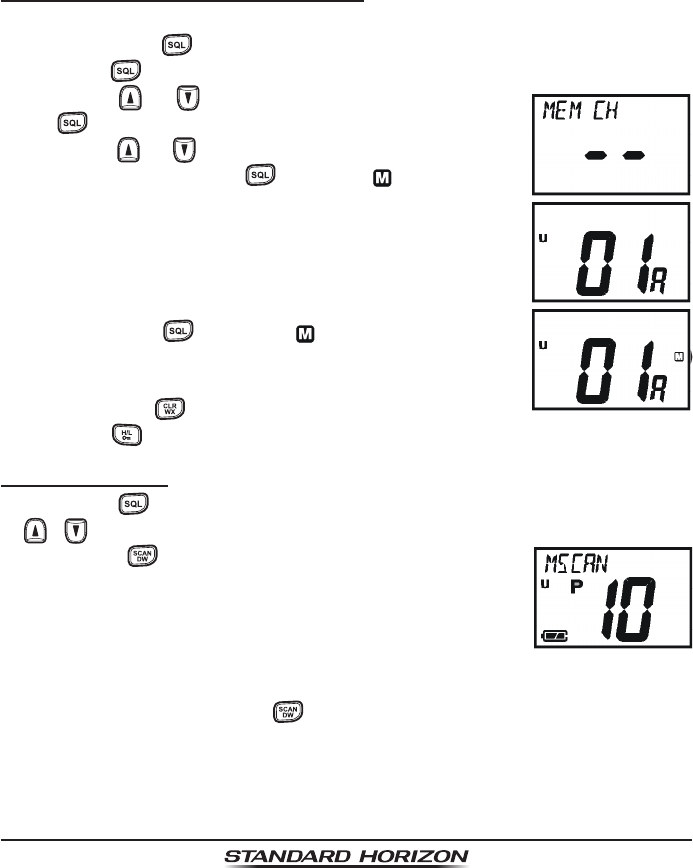
HX380Page 24
6.8 MEMORY SCAN
The HX380 will automatically scan channels programmed into Preset Channel
Memory and also channels store into Scan Memory.
When an incoming signal is detected on one of the channels during scan, the
radio will pause on that channel, allowing you to listen to the incoming trans-
mission. The radio will automatically start scanning again after the transmis-
sion stops.
6.8.1 PROGRAMMING SCAN MEMORY
1. Turn the transceiver off by rotating the VOL knob fully counter-clockwise.
2. Hold down the key, and then turn on the transceiver while still holding
down the key.
3. Press the or key to select “MEM CH” and press
the key.
4. Press the or key to select desired channel to be
scanned, then press the key. The “ ” icon appears
on the display, which indicates the channel has been
selected to the scan channel.
5. Repeat step 4 for all the desired channels to be pro-
grammed into scan memory.
6. To DELETE a channel from the list, select the channel
then press the key. The “ ” icon disappears from
the display.
7. When you have completed programming the scan mem-
ory, press the key to save your changes, and then
press the key to exit to normal operation.
6.8.2 OPERATION
1. Press the key to activate the squelch adjusting mode, then press the
/ key until the background noise disappears.
2. Press the key to start scanning channels pro-
grammed into memory and preset channels. “MSCAN”
will be shown in the upper left corner of the display.
3. When the HX380 receives a transmission, it will stop on
the channel until the incoming signal disappears, then
start scanning again.
4. To stop scanning, press the key.
Application for FCC/IC
FCC ID: K6630393X20
IC: 511B-30393X20
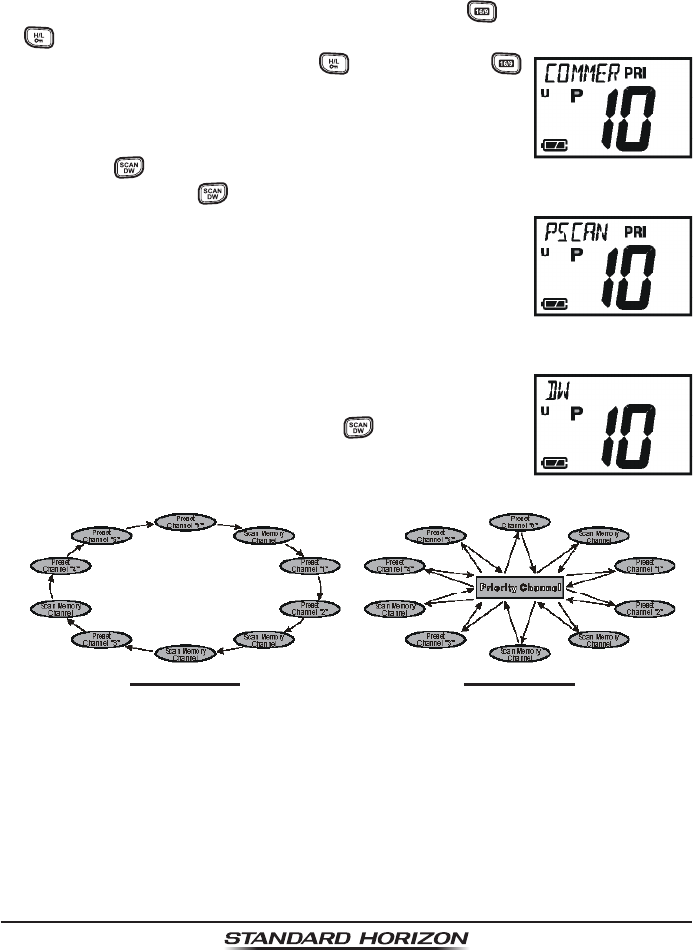
Page 25HX380
6.9 PRIORITY SCAN
The Priority Scan is similar to the Memory Scan. However, the Priority Scan
monitors the Preset Channels, Scan Memory Channels and the Priority Chan-
nel. The following channels can be set as the Priority channel: CH16, CH9, or
one of the Preset channel (default setting is CH16).
1. To set the priority channel, hold down the key and press the
key. The channel will change from 16 to 09 to Preset channels 0
through 9 with each press of the key. When the
key is released the displayed channel will be set as the
priority channel (the “PRI” icon will appear above of the
channel number).
2. Press the key to start Scanning.
3. Press and hold the key to start Priority Scan, “PSCAN” will be shown on
the display.
4. When the HX380 receives a transmission on a working
channel, it will stop on the working channel and dual
watch to the priority channel until the incoming signal
disappears, then start scanning again.
5. When the HX380 receives a signal on the Priority channel it will stay on this
channel until the incoming signal disappears, then start
Priority scanning again.
6. To stop Priority Scanning, press the key.
“PrIorIty” SCAn
“MeMory” SCAn
Application for FCC/IC
FCC ID: K6630393X20
IC: 511B-30393X20
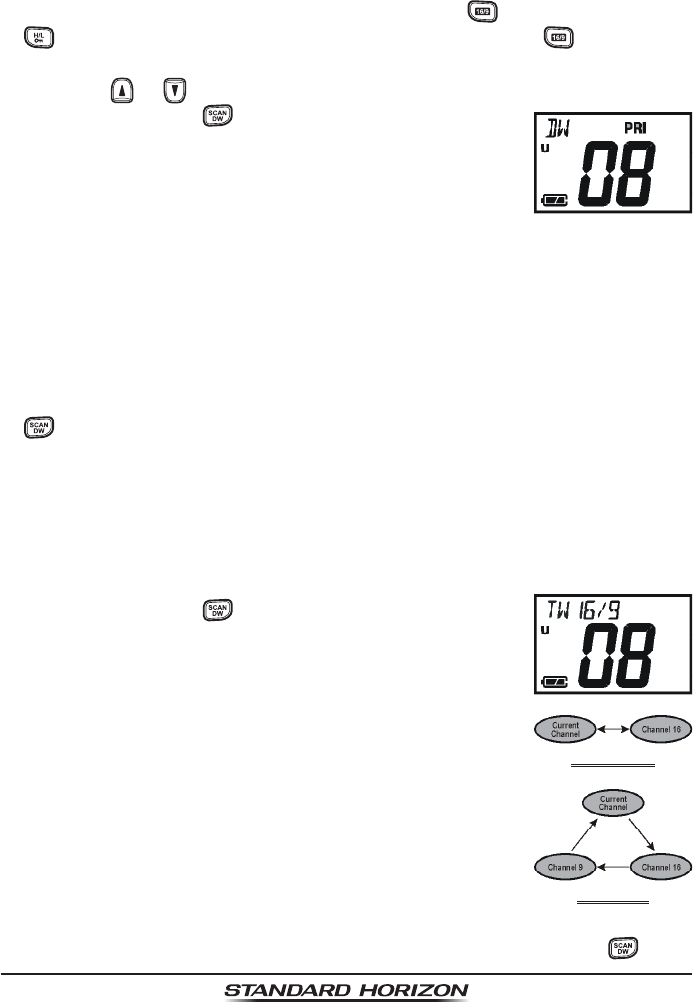
HX380Page 26
6.10 DUAL WATCH
The Dual Watch feature allows the radio to scan between the Priority Channel
and one other channel.
1. To set the Priority channel, hold down the key and press the
key, when the channel you want is shown, release the key.
2. Select the desired channel you want to Dual watch to the priority channel
using the or key.
3. Press and hold the key for two seconds to activate
the Dual Watch feature. A “DW” notation will appear on
the upper left corner of the display when the Dual Watch
feature is activated.
4. When a transmission is received on the “Priority” chan-
nel, the radio will stay on the “Priority Channel” until the incoming signal
disappears.
5. When the radio receives a transmission on the working channel, the radio
will Dual Watch between the working channel and Priority channel.
6. The radio will resume Dual Watch when the incoming signal disappears at
the end of the transmission.
7. To stop the Dual Watch feature and return to normal operation, press the
key briey.
6.11 TRI-WATCH
You may change the Dual Watch feature to Tri-watch via the Menu (“Set”)
Mode. Refer to Menu Mode Item “DUAL WATCH MODE” on page 28 for details.
Tri-Watch scans Channel 16, 9, and one other channel. When enabled the
HX380 will show “TW 16/9” in the upper left corner of the display.
1. Press and hold the key for two seconds to activate
the TRI-Watch feature. “TW 16/9” will appear on the up-
per left corner of the display when the Tri-Watch feature
is activated.
2. When a transmission is received on the channel 16, ra-
dio will stay on the channel 16 until the incoming signal
disappears.
3. When a transmission is received on the channel 9, the
radio will Dual watch between the channel 16 and chan-
nel 9.
4. When the radio receives a transmission on the working
channel, the radio will Tri-watch between the working
channel, channel 16 and channel 9.
5.
To stop the Tri-watch feature and return to normal operation, press the key.
trI-WAtCh
dUAl WAtCh
Application for FCC/IC
FCC ID: K6630393X20
IC: 511B-30393X20
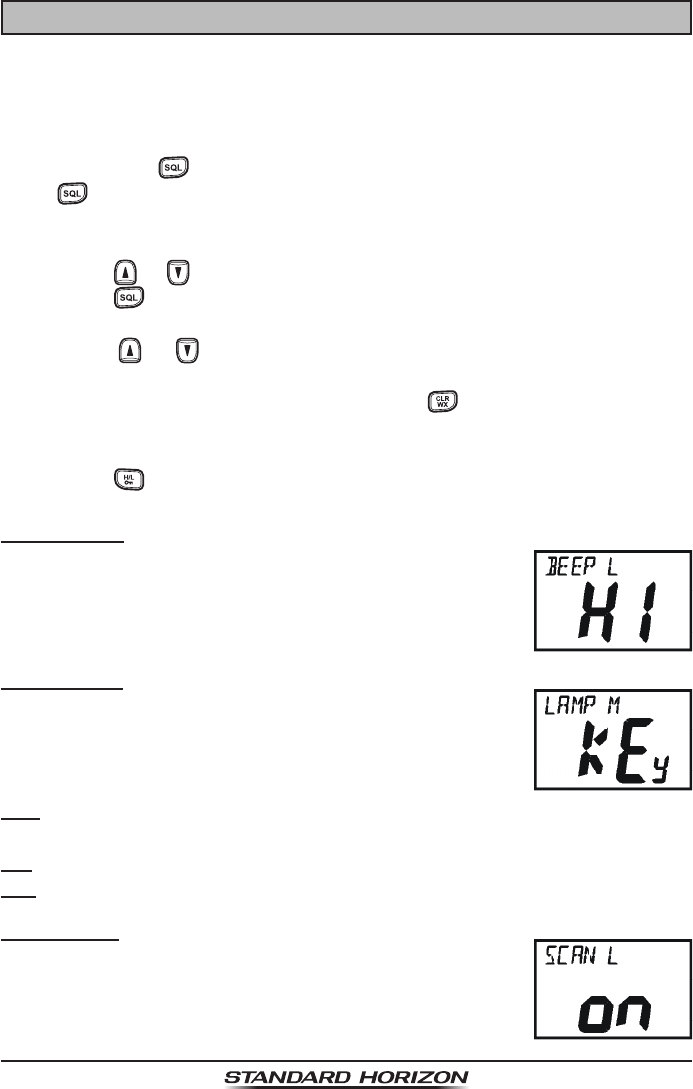
Page 27HX380
7. MENU (“SET”) MODE
The Setup Menu allows a number of the HX380 operating parameters to be
custom-congured for your operating requirements.
The Menu Mode is easy to activate and set, using the following procedure:
1. Turn the transceiver off by rotating the VOL knob fully counter-clockwise.
2. Hold down the key, then turn on the transceiver while still holding down
the key.
3. The Menu item will scroll on the upper left corner of the display and its cur-
rent status or value will appear on the large display.
4. Press the or key to select the Menu item to be adjusted.
5. Press the key to enable adjustment of the selected Menu item. The cur-
rent status or value will blink.
6. Press the or key to select the desired status or value of the Menu
item.
7. After completing your adjustment, press the key to save the new set-
ting.
8. If you wish to change another Menu item, repeat steps 4 to 7 above.
9. Press the key to exit to normal operation.
BEEP LEVEL
Function: Enables/Disables the Keypad beep.
Available Values: HI / Lo / oFF
Default: HI
LAMP MODE
Function: Selects the Lamp illumination method for the
LCD/Keypad.
Available Values: KEY / Cnt (Continuous) / oFF
Default: KEY
KEY: Illuminates the LCD/Keypad for 5 seconds when any key is
pressed.
Cnt (Continuous): Illuminates the LCD/Keypad continuously.
oFF: Turns off the backlight for the LCD and keys.
SCAN LAMP
Function: Enables/Disables the Lamp while scanner is
paused.
Available Values: on / oFF
Default: on
Application for FCC/IC
FCC ID: K6630393X20
IC: 511B-30393X20
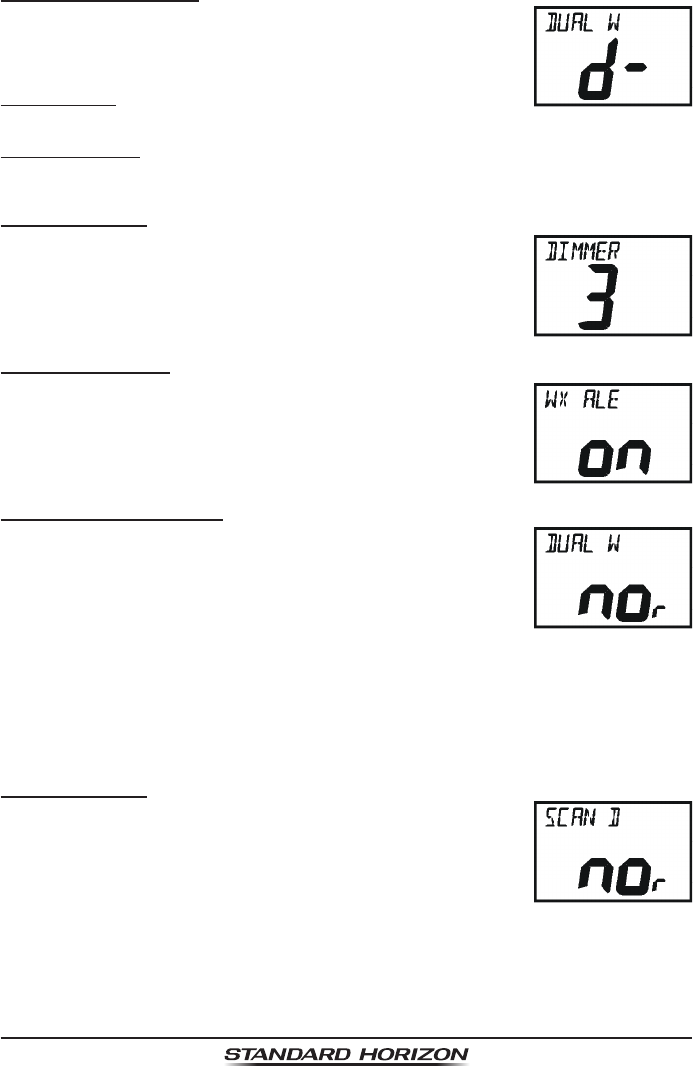
HX380Page 28
DUAL WATCH MODE
Function: Selects dual or tri-watch as desired.
Available Values: t- (Tri Watch) / d- (Dual Watch)
Default: d- (Dual Watch)
t- (Tri Watch): The radio watches the activity of CH16,
CH9, and the current channel.
d- (Dual Watch): The radio watches the the activity of the current channel and
the Priority channel.
DIMMER MODE
Function: Selects the display brightness level.
Available Values: 0 / 1 / 2 / 3
Default: 3
WX ALERT MODE
Function: Enables/Disables the NOAA Weather Alert func-
tion.
Available Values: on / oFF
Default: on
DUAL WATCH DISPLAY
Function: Selects the display mode while Dual Watch
scanning.
Available Values: nor (Normal) / SPC (Special)
Default: nor (Normal)
When this menu is set to “Normal”, the channel numbers during dual watch
will be shown scrolling on the display. When “Special” is selected the channel
numbers on the display do not change unless a call was received. The chan-
nel shown is the last channel that was received. This is a handy feature if you
cannot look at the radio the moment a transmission was received.
SCAN DISPLAY
Function: Selects display mode while scanning.
Available Values: nor (Normal) / SPC (Special)
Default: nor (Normal)
When this menu is set to “Normal”, the channel numbers
during dual watch will be shown scrolling on the display. When “Special” is
selected the channel numbers on the display do not change unless a call was
received. The channel shown is the last channel that was received. This is a
handy feature if you cannot look at the radio the moment a transmission was
received.
Application for FCC/IC
FCC ID: K6630393X20
IC: 511B-30393X20
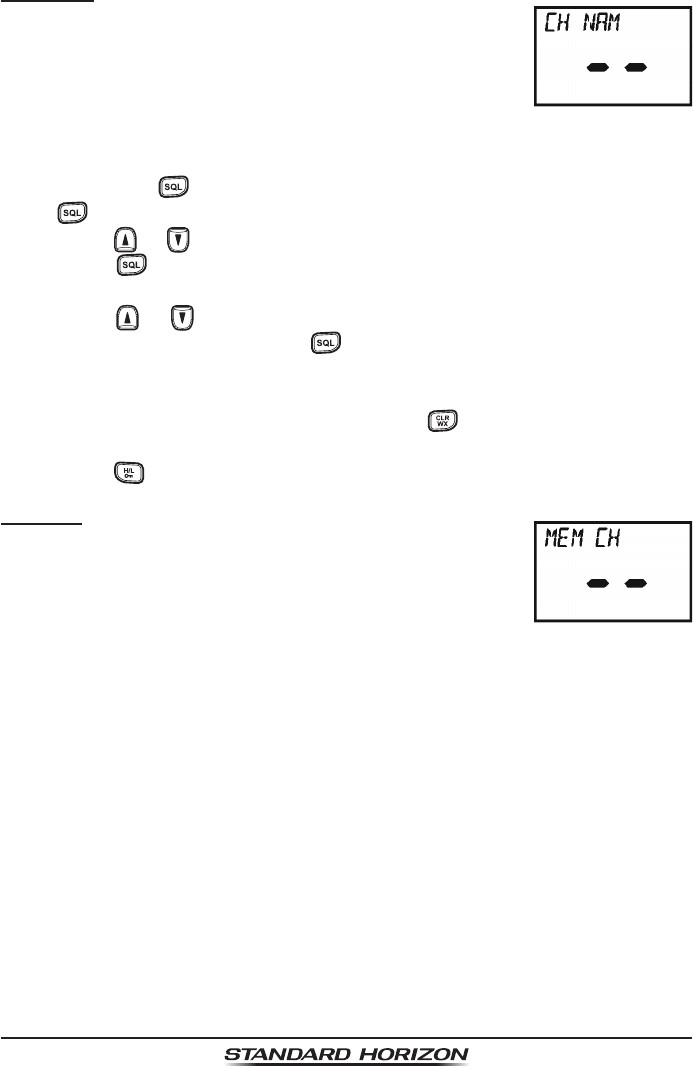
Page 29HX380
CH NAME
Function: Changes the channel name shown on the dis-
play.
To change the channel name:
1. Select the channel you wish to change the name before
following the steps below.
2. Turn off the HX380 by rotating the VOL knob counter clockwise.
3. Hold down the key, then turn on the transceiver while still holding down
the key.
4. Press the or key to select “CH NAME”.
5. Press the key. The current channel name will appear on the upper left
corner of the display.
6. Press the or key to select the rst character (letter, number, or sym-
bol) in the name, then press the key to move to the next character.
7. Repeat step 6 as many times as necessary to complete the name tag (up
to 12 characters).
8. After completing your adjustment, press the key to save the new set-
ting.
9. Press the key to exit to normal operation.
MEM CH
Function: Programming Scan Memory.
See page 24 for details of the programming.
Application for FCC/IC
FCC ID: K6630393X20
IC: 511B-30393X20

HX380Page 30
8. MAINTENANCE
8.1 GENERAL
The inherent quality of the solid-state components in STANDARD HORIZON
radios will provide many years of continuous use. Take the following precau-
tions to prevent damage to the radio.
To prevent corrosion of electrical contacts and keep the water resistance,
keep the microphone or the jack connected at all times.
Never press the PTT switch unless an antenna or suitable dummy load is
connected to the antenna receptacle.
Ensure that the input voltage does not exceed the value specied in your
Owner’s Manual.
Use only STANDARD HORIZON-approved accessories and replacement
parts.
8.2 REPLACEMENT PARTS
Occasionally an owner needs a replacement part. Items can be ordered from
our Parts Department by writing or calling (in USA or Canada), or Standard
Horizon/Yaesu authorized dealers (outside USA or Canada).
Marine Division of YAESU U.S.A.
6125 Phyllis Drive, Cypress, CA 90630, U.S.A.
Telephone (800) 767-2450
Commonly requested parts, and their part numbers are listed below.
CAT460 Antenna: AY139X001
VOL Knob: RA1193900
MIC/SP Rubber Cap: RA1194200
MIC/SP Plastic Cap: RA108700B
Belt Clip: RA060190A
Application for FCC/IC
FCC ID: K6630393X20
IC: 511B-30393X20
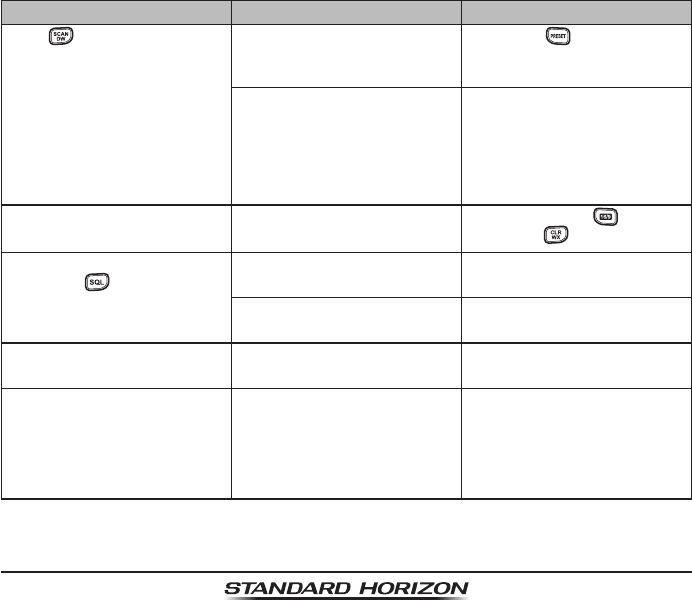
Page 31HX380
8.3 FACTORY SERVICE
In the unlikely event that the radio fails to perform or needs servicing, please
contact the following:
For repairs In USA
Standard Horizon
Attention Marine Repair Department
6125 Phyllis Drive, Cypress, CA 90630
Telephone (800) 366-4566
For repairs In Canada
Westcom Marine
488 East 62 nd Avenue
Vancouver BC V5X2G1
Telephone (604) 327-6280
An “RA” Return Authorization number is not necessary to send a product in
for service. Include a brief note describing the problem along with your name,
return address, phone number, and proof of purchase.
8.4 TROUBLESHOOTING CHART
SYMPTOM PROBABLE CAUSE REMEDY
The key does not start
the scan.
No channels memorized. Use the key to enter
desired channels into the
Preset memory.
Squelch is not adjusted. Adjust the squelch to thresh-
old or to the point where
noise just disappears.
Further adjustment of the
squelch control may elimi-
nate incoming signals.
Cannot select between USA,
INTL, or Canadian bands.
Proper operation not fol-
lowed.
HOLD down the key and
press the key.
Speaker audio is not heard
when the key is pressed
and held.
Low battery. Charge battery. Refer to sec-
tion 4.3.3 of this manual.
Audio volume level is too
low.
Turn the VOL knob clock-
wise.
Some keys do not operate. Key Lock is on. Turn the Key Lock off. Refer
to section 6.6 of this manual.
Charging indicator on CD-48
does not illumininate.
Defective battery FNB-
V105LI.
Battery contacts not making
contact with the charger cra-
dle.
Contact Standard Horizon
Product Support at (800)767-
2450.
Application for FCC/IC
FCC ID: K6630393X20
IC: 511B-30393X20

HX380Page 32
9. VHF MARINE CHANNEL ASSIGNMENTS
Tables on the following pages list the VHF Marine Channel assignments for
U.S.A. and International use. Below are listed some data about the charts.
1. VTS. Where indicated, these channels are part of the U.S. Coast Guard’s
Vessel Trafc System.
2. Alpha channel numbers, that is, channel numbers followed by the letter A
(such as Channel 07A) are simplex channels on the U.S.A. or Canadian
channel assignments whose counterparts in the International assignments
are duplex channels. International channels do not use “alpha” numbers.
If you call the Coast Guard on Channel 16, they will sometimes ask you to
“go to channel 22 Alpha.” This is a channel assigned to U.S.A, and Ca-
nadian Coast Guards for handling distress and other calls. If your radio is
set for International operation you will go to Channel 22 instead of 22A,
and will not be able to communicate with the Coast Guard. To use Channel
22A, your radio must be set for USA or Canada operation, usually by a U/
I/C (USA/International/Canada) control or combination of controls. Channel
22 (without an “A”) is an International duplex channel for port operations.
Some radios indicate an “A” adjacent to the alpha channels on the display;
on others “alpha” is not indicated but the proper channel is selected based
on the U/I/C setting.
3.
Bridge-to-Bridge channels (for example, Channel 13) are for use by bridge op-
erators on inter-coastal waterways and rivers. It is also used by marine vessels
in the vicinity of these bridges for navigation and for communicating with the
bridge operators. Note that a limit of 1 Watt is specied for these channels.
4. The S/D column on the chart indicates either S (simplex) or D (duplex).
Simplex means transmitting and receiving on the same frequency. Only
one party at a time can talk, unlike a telephone. Be sure to say “over” and
release your microphone push-to-talk switch at the end of each transmis-
sion. Duplex operation involves the use of one frequency for transmitting
and a separate frequency for receiving. On channels specied as duplex on
the charts, correct mode of operation is established automatically by your
radio when you select a channel; you cannot change the mode. And you
still must release the push-to-talk switch after each transmission in order to
listen to the radio.
5. Channels normally used by recreational boaters are those that include the
term “non-commercial” in the Channel Use column of the chart. Some of
these are shared with other users and some are used only in certain geo-
graphic regions.
6.
Marine vessels equipped with VHF radios are required to monitor Channel 16.
Application for FCC/IC
FCC ID: K6630393X20
IC: 511B-30393X20
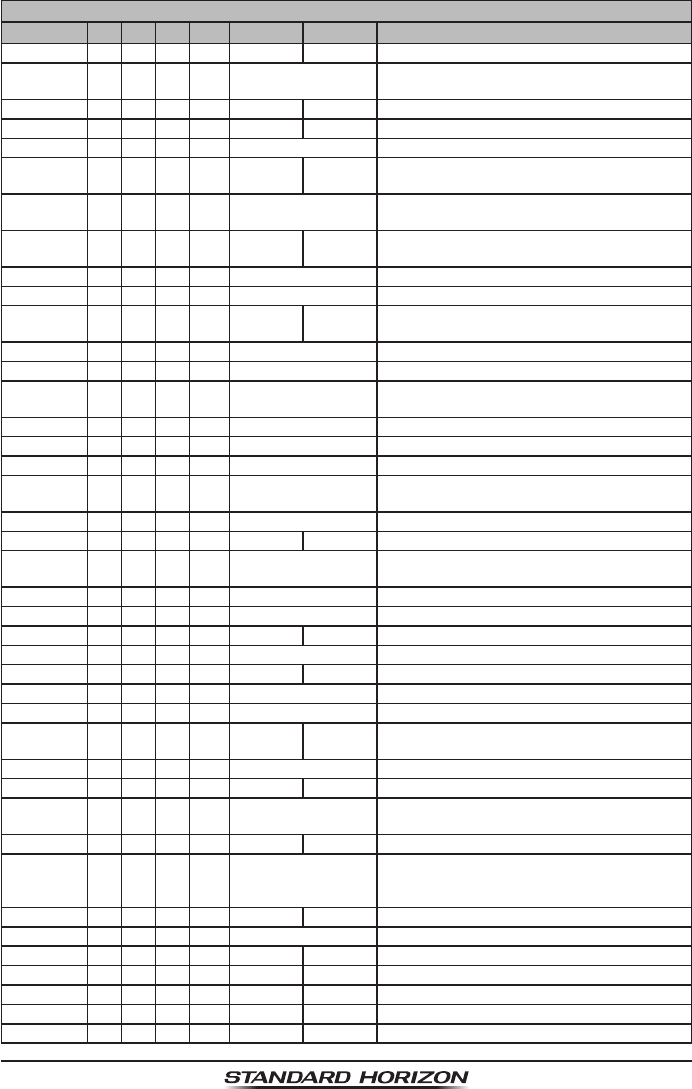
Page 33HX380
VHF MARINE CHANNEL CHART
CH U C I S/D TX RX CHANNEL USE
01 X X D 156.050 160.650 Public Correspondence (Marine Operator)
01A X S 156.050 Port Operation and Commercial.
VTS in selected areas
02 X X D 156.100 160.700 Public Correspondence (Marine Operator)
03 X X D 156.150 160.750 Public Correspondence (Marine Operator)
03A X S 156.150 U.S. Government Only, Coast Guard
04 X D 156.200 160.800 Public Correspondence (Marine Opera-
tor),Port operation, ship movement
04A X S 156.200 Pacic coast: Coast Guard, East Coast:
Commercial shing
05 X D 156.250 160.850 Public Correspondence (Marine Operator),
Port operation, ship movement
05A X X S 156.250 Port operation. VTS in Seattle
06 X X X S 156.300 Inter-ship Safety
07 X D 156.350 160.950 Public Correspondence (Marine Operator),
Port operation, ship movement
07A X X S 156.350 Commercial
08 X X X S 156.400 Commercial (Inter-ship only)
09 X X X S 156.450 Boater Calling channel, Commercial &
Non-commercial (Recreational)
10 X X X S 156.500 Commercial
11 X X X S 156.550 Commercial. VTS in selected areas.
12 X X X S 156.600 Port operation. VTS in selected areas.
13 X X X S 156.650 Inter-ship Navigation Safety (Bridge-to-
bridge)
14 X X X S 156.700 Port operation. VTS in selected areas.
15 X S - - - 156.750 Environmental (Receive only)
15 X X S 156.750 Commercial, non-commercial, ship move-
ment (1 W)
16 X X X S 156.800 International Distress, Safety and Calling
17 X X X S 156.850 State Controlled (1 W)
18 X D 156.900 161.500 Port operation, ship movement
18A X X S 156.900 Commercial
19 X D 156.950 161.550 Port operation, ship movement
19A X S 156.950 US: Commercial
19A X S 156.950 Coast Guard
20 X X X D 157.000 161.600 Canadian Coast Guard Only,
International: port operations and shipment
20A X S 157.000 Port operation
21 X D 157.050 161.650 Port operation, ship movement
21A X X S 157.050 U.S. Government Only, Canadian Coast
Guard
22 X D 157.100 161.700 Port operation, ship movement
22A X X S 157.100
US and Canadian Coast Guard Liaison and
Maritime Safety Information Broadcasts an-
nounced on channel 16
23 X X D 157.150 161.750 Public Correspondence (Marine Operator)
23A X S 157.150 U.S. Government Only
24 X X X D 157.200 161.800 Public Correspondence (Marine Operator)
25 X X X D 157.250 161.850 Public Correspondence (Marine Operator)
26 X X X D 157.300 161.900 Public Correspondence (Marine Operator)
27 X X X D 157.350 161.950 Public Correspondence (Marine Operator)
28 X X X D 157.400 162.000 Public Correspondence (Marine Operator)
Application for FCC/IC
FCC ID: K6630393X20
IC: 511B-30393X20
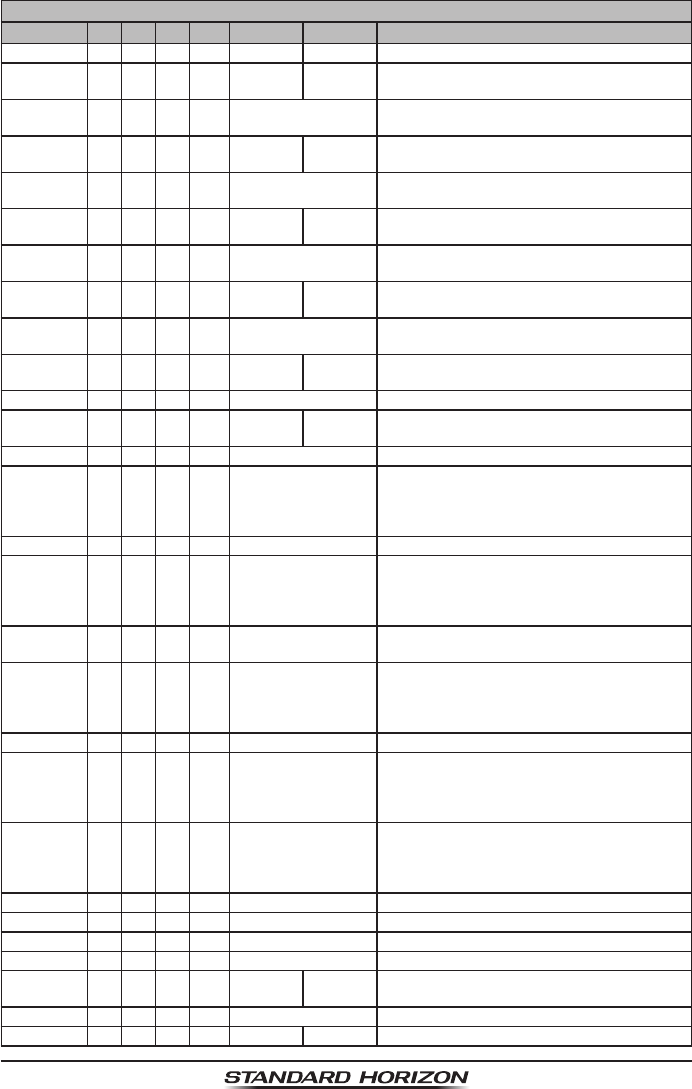
HX380Page 34
VHF MARINE CHANNEL CHART
CH U C I S/D TX RX CHANNEL USE
60 X X D 156.025 160.625 Public Correspondence (Marine Operator)
61 X D 156.075 160.675 Public Correspondence (Marine Operator),
Port operation, ship movement
61A X X S 156.075 Public Coast: Coast Guard;
East Coast: commercial shing only
62 X D 156.125 160.725 Public Correspondence (Marine Operator),
Port operation, ship movement
62A X S 156.125 Public Coast: Coast Guard;
East Coast: commercial shing only
63 X D 156.175 160.775 Public Correspondence (Marine Operator),
Port operation, ship movement
63A X X S 156.175 Port Operation and Commercial.
VTS in selected areas.
64 X X D 156.225 160.825 Public Correspondence (Marine Operator),
Port operation, ship movement
64A X X S 156.225 Public Correspondence (Marine Opera-
tor), Port operation, ship movement
65 X D 156.275 160.875 Public Correspondence (Marine Operator),
Port operation, ship movement
65A X X S 156.275 Port Opeations
66 X D 156.325 160.925 Public Correspondence (Marine Operator),
Port operation, ship movement
66A X X S 156.325 Port Operations
67 X X X S 156.375
US: Commercial. Used for Bridge-to-bridge
communications in lower Mississippi River.
Inter-ship only.
Canada: Commercial shing, S&R
68 X X X S 156.425 Non-commercial (Recreational)
69 X X X S 156.475
US: Non-commercial (Recreational),
Canada: Commercial shing only,
International: Inter-ship, Port operations
and Ship movement
70 X X X S 156.525 Digital selective calling (voice communica-
tions not allowed)
71 X X X S 156.575
US, Canada: Non-commercial (Recreation-
al),
International: Port opertions and Ship
movement
72 X X X S 156.625 Non-commercial (Inter-ship only)
73 X X X S 156.675
US: Port Operations,
Canada: Commercial sh ing only,
International: Inter-ship, Port operations
and Ship movement
74 X X X S 156.725
US: Port Operations,
Canada: Commercial shing only,
International: Inter-ship, Port opertions and
Ship movement
75 X X X S 156.775 Port Operations (Inter-ship only) (1W)
76 X X X S 156.825 Port Operations (Inter-ship only) (1W)
77 X X S 156.875 Port Operations (Inter-ship only) (1W)
77 X S 156.875 Port Operations (Inter-ship only)
78 X D 156.925 161.525 Public Correspondence (Marine Operator),
Port operation, ship-movement
78A X X S 156.925 Non-commercial (Recreational)
79 X D 156.975 161.575 Port operation and Ship movement
Application for FCC/IC
FCC ID: K6630393X20
IC: 511B-30393X20
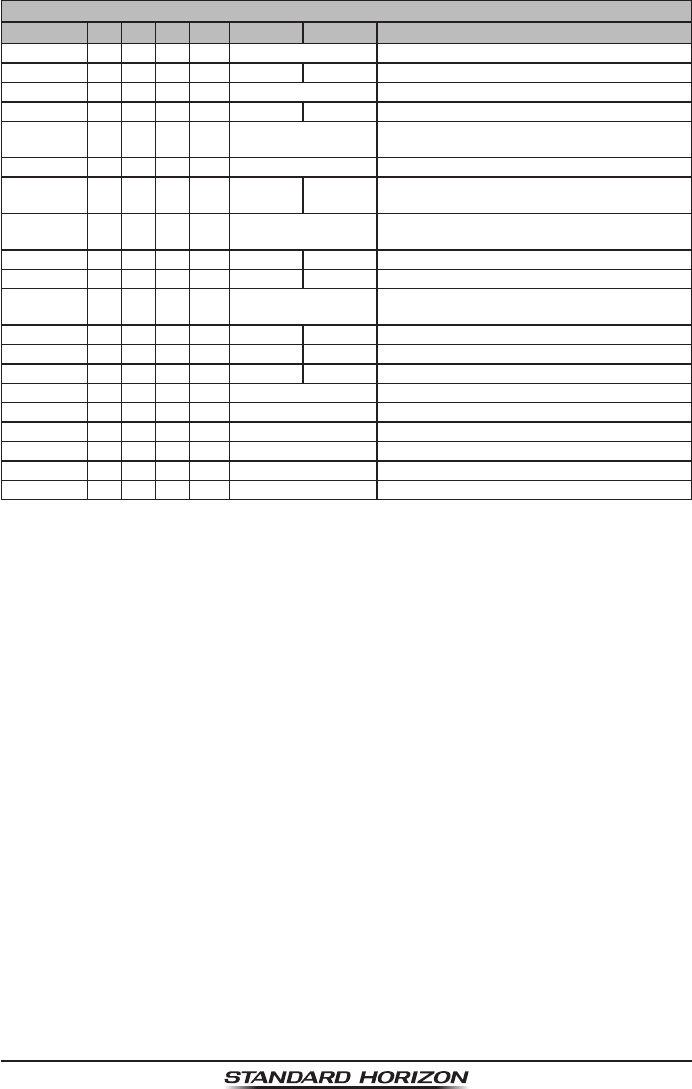
Page 35HX380
VHF MARINE CHANNEL CHART
CH U C I S/D TX RX CHANNEL USE
79A X X S 156.975 Commercial
80 X D 157.025 161.625 Port operation, ship movement
80A X X S 157.025 Commercial
81 X D 157.075 161.675 Port operation, ship movement
81A X S 157.075 U.S. Government Only -
Environmental protection operations.
81A X S 157.075 Canadian Coast Guard Only
82 X D 157.125 161.725 Public Correspondence (Marine Operator),
Port operation, ship movement
82A X X S 157.125 U.S. Government Only,
Canadian Coast Guard Only
83 X D 157.175 161.775 Canadian Coast Guard Only
83 X D 157.175 161.775 Public Correspondence (Marine Operator)
83A X X S 157.175 U.S. Government Only,
Canadian Coast Guard Only
84 X X X D 157.225 161.825 Public Correspondence (Marine Operator)
85 X X X D 157.275 161.875 Public Correspondence (Marine Operator)
86 X X X D 157.325 161.925 Public Correspondence (Marine Operator)
87 X X S 157.375 Port operation, ship movement
87A X S 157.375 Public Correspondence (Marine Operator)
88 X X S 157.425 Port operation, ship movement
88A X S 157.425 Commercial, Inter-ship Only
NOTE: Simplex channels, 3A, 21A, 23A, 61A, 64A, 81A, 82A and 83A CANNOT be lawfully used
by the general public in U.S.A. waters.
Application for FCC/IC
FCC ID: K6630393X20
IC: 511B-30393X20

HX380Page 36
10. WARRANTY
Marine Products Limited Warranty
PLEASE NOTE
The following “Limited Warranty” is for valid for products that have
been purchased in the United States and Canada. For limited War-
ranty details outside the United States, contact the dealer in your
country.
STANDARD HORIZON (a division of YAESU U.S.A.) warrants, to the original
purchaser only, each new Marine Communications Product (“Product”) manu-
factured and/or supplied by STANDARD HORIZON against defects in materi-
als and workmanship under normal use and service for a period of time from
the date of purchase as follows:
Fixed Mount and Portable Transceivers
1 year - if purchased before 01/01/91
3 years - if purchased between 01/01/91 and 01/01/94
3 years Waterproof - if purchased after 01/01/94
Loud hailers
1 year - if purchased before 01/01/91
3 years - if purchased after 01/01/91
Associated Chargers
1 year - if purchased before 01/01/91
3 years - if purchased after 01/01/91
Associated Batteries - 1 year. Note: Batteries will be deemed deective only
if storage capacity drops below 80% of rated capacity or if leakage develops.
Associated Accessories -
1 year. Includes: Microphones/Handsets, External
Speakers, Antennas, Carrying Accessories, Power Supplies, and Signaling Boards.
To receive warranty service, the purchaser must deliver the Product, transpor-
tation and insurance prepaid, to STANDARD HORIZON (a division of YAESU
U.S.A.), Attention Marine repairs 6125 Phyllis Drive, Cypress, CA 90630.
Include proof of purchase indicating model. serial number, and date of pur-
chase. STANDARD HORIZON will return the Product to the purchaser freight
prepaid. Products purchased prior to January 1, 1991 will bear the STAN-
DARD HORIZON warranty terms in effect prior to that date.
In the event of a defect, malfunction or failure of the Product during the war-
ranty period, STANDARD HORIZON’s liability for any breach of contract or
any breach of express or implied warranties in connection with the sale of
Products shall be limited solely to repair or replacement, at its option, of the
Application for FCC/IC
FCC ID: K6630393X20
IC: 511B-30393X20

Page 37HX380
Product or part(s) therein which, upon examination by STANDARD HORIZON,
appear to be defective or not up to factory specications. STANDARD HORI-
ZON may, at its option, repair or replace parts or subassemblies with new or
reconditioned parts and subassemblies. Parts thus repaired or replaced are
warranted for the balance of the original applicable warranty.
STANDARD HORIZON will not warrant installation, maintenance or service of
the Products. In all instances, STANDARD HORIZON’s liability for damages
shall not exceed the purchase price of the defective Product.
This warranty only extends to Products sold within the 50 States of the United
States of America and the District of Columbia.
STANDARD HORIZON will pay all labor to repair the product and replace-
ment parts charges incurred in providing the warranty service except where
purchaser abuse or other qualifying exceptions exist. The purchaser must pay
any transportation expenses incurred in returning the Product to STANDARD
HORIZON for service.
This limited warranty does not extend to any Product which has been subjected
to misuse, neglect, accident, incorrect wiring by anyone other than STANDARD
HORIZON, improper installation, or subjected to use in violation of instructions
furnished by STANDARD HORIZON, nor does this warranty extend to Products
on which the serial number has been removed, defaced, or changed. STAN-
DARD HORIZON cannot be responsible in any way for ancillary equipment not
furnished by STANDARD HORIZON which is attached to or used in connection
with STANDARD HORIZON’s Products, or for the operation of the Product with
any ancillary equipment, and all such equipment is expressly excluded from this
warranty. STANDARD HORIZON disclaims liability for range, coverage, or op-
eration of the Product and ancillary equipment as a whole under this warranty.
STANDARD HORIZON reserves the right to make changes or improvements
in Products, during subsequent production, without incurring the obligation to
install such changes or improvements on previously manufactured Products.
The implied warranties which the law imposes on the sale of this Product
are expressly LIMITED, in duration, to the time period specified above.
STANDARD HORIZON shall not be liable under any circumstances for con-
sequential damages resulting from the use and operation of this Product,
or from the breach of this LIMITED WARRANTY, any implied warranties,
or any contract with STANDARD HORIZON. IN CONNECTION WITH THE
SALE OF ITS PRODUCTS, STANDARD HORIZON MAKES NO WAR-
RANTIES, EXPRESS OR IMPLIED AS TO THE MERCHANTABILITY OR
FITNESS FOR A PARTICULAR PURPOSE OR OTHERWISE, EXCEPT AS
EXPRESSLY SET FORTH HEREIN.
Application for FCC/IC
FCC ID: K6630393X20
IC: 511B-30393X20

HX380Page 38
Some states do not allow the exclusion or limitation of incidental or conse-
quential damages, or limitation on how long an implied warranty lasts, so the
above limitations or exclusions may not apply. This warranty gives specic le-
gal rights, and there may be other rights which may vary from state to state.
ONLY PRODUCTS SOLD ON OR AFTER JANUARY 1, 1991 ARE COVERED
UNDER THE TERMS OF THIS LIMITED WARRANTY.
ON-LINE WARRANTY REGISTRATION
THANK YOU for purchasing a Standard Horizon products! We are con-
dent your new radio will serve your needs for many years!
Please visit www.standardhorizon.com to register the HX380 Marine
VHF. It should be noted that visiting the Web site from time to time may
be benecial to you, as new products are released they will appear on the
STANDARD HORIZON Web site. Also a statement regarding product sup-
port should be added to the manual.
Product Support Inquiries
If you have any questions or comments regarding the use of the HX380,
you can visit the STANDARD HORIZON Web site to send an E-Mail or
contact the Product Support team at (800) 767-2450 M-F 8:00AM to
5:00PM PST.
In addition to the warranty, STANDARD HORIZON includes a lifetime “at
rate” and “customer loyalty” programs to provide service after the warranty
period has expired. If you wish to obtain the at rate price for out-of-war-
ranty repair, you must include the information on the Owner’s Record with
the unit when you return it to your Dealer or to STANDARD HORIZON.
Lifetime Flat Rate Service Program: For the original Owner only, for the
lifetime of the unit, STANDARD HORIZON will repair the unit to original
specications.
Note: The at rate amount is payable by the Owner only if STANDARD
HORIZON or the STANDARD HORIZON Dealer determines that a repair
is needed. After the repair, a 90-day warranty will be in effect from the
date of return of the unit to the Owner.
This service program is not available for equipment which has failed as
a result of neglect, accident, breakage, misuse, improper installation or
modication, or water damage (depending on the product).
Application for FCC/IC
FCC ID: K6630393X20
IC: 511B-30393X20
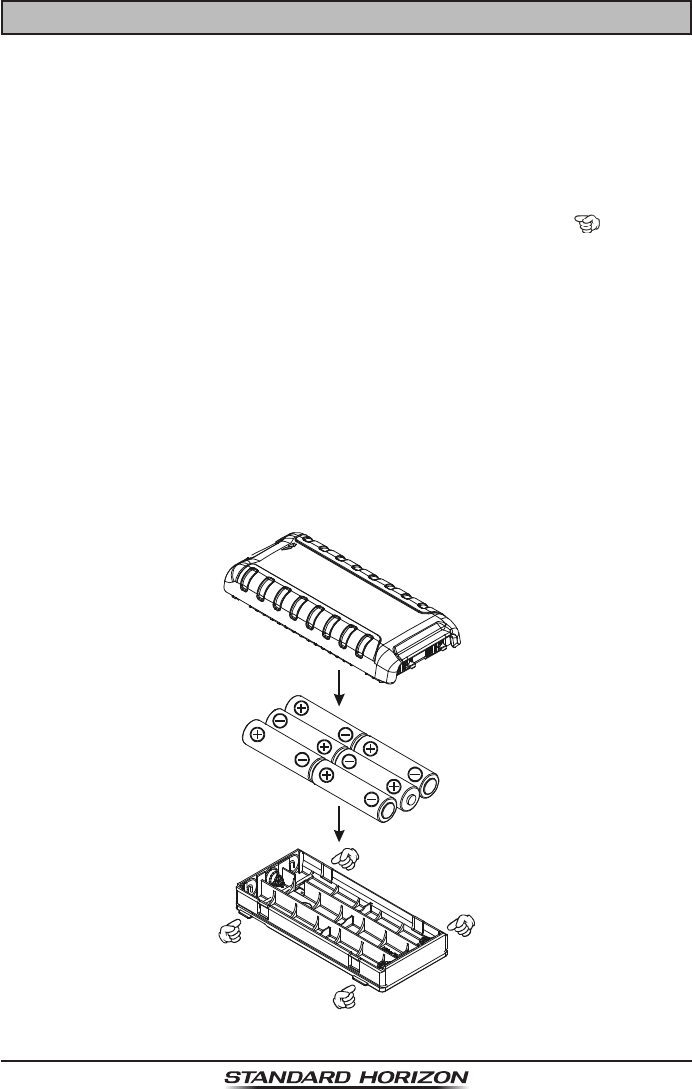
Page 39HX380
11. INSTALLATION OF OPTION
11.1 FBA-40 ALKALINE BATTERY TRAY
FBA-40 is a battery tray that holds six AA size Alkaline batteries and is used
with the HX380 transceiver. When the FBA-40 is installed into the HX380 the
radio can withstand immersion in water up to 1.5 m (about 5Ft) for 30 minutes.
1. On the FBA-40, remove the battery case cover. Due to the battery case
water proof characteristics, it may be difficult to remove the battery tray
case, put a coin to the edge of the battery compartment ( ) then pry
open the battery case cover.
2. Slide the six AA size Alkaline batteries into the FBA-40 Battery Case with
the Negative (–) side of the batteries touching the spring connections inside
the FBA-40 Battery Case.
3. Attach the battery cover to the FBA-40 Battery Case while being careful so
that o-ring is not twisted.
4. Insert the FBA-40 Battery Case into the battery compartment on the back
of the HX380 transceiver while tilting the Belt Clip outward, then push the
bottom side of the FBA-40 Battery Case until the Battery Case locks with
the Battery Pack Latch.
Application for FCC/IC
FCC ID: K6630393X20
IC: 511B-30393X20

HX380Page 40
12. SPECIFICATIONS
Performance specications are nominal, unless otherwise indicated, and are
subject to change without notice.
12.1 GENERAL
Frequency Ranges: 156.025 MHz - 163.275 MHz
(Marine Band + WX Band)
134.000 MHz - 174.000 MHz
(LMR Band)
Channel Spacing: 25 kHz / 12.5 kHz
Frequency Stability: ±2.5 ppm
(–22 °F to +140 °F [–30 °C to +60 °C])
Emission Type: 16K0G3E (Marine Band)
16K0F3E (LMR Band: Wide)
11K0F3E (LMR Band: Narrow)
Antenna Impedance: 50
Supply Voltage: 7.4V DC, Negative Ground
(Battery Terminal)
Current Consumption: 320 mA (Receive, Typical at AF MAX.)
50 mA (Standby)
1.6 A / 0.8 A (TX: 5 W / 1W)
Operating Temperature: –22 °F to +140 °F (–30 °C to +60 °C)
Case Size (W x H x D): 2.24” x 5.24” x 1.29” (57 x 133 x 33 mm)
w/o knob & antenna
Weight (Approx.): 11.3 oz (320 g)
w/FNB-V105LI, Belt Clip, & Antenna
12.2 TRANSMITTER
RF Power Output: 5 W / 1 W (@7.4 V )
Modulation Type: Variable Reactance
Maximum Deviation: ±5.0 kHz (Wide) / ±2.5 kHz (Narrow)
Spurious Emission: –36 dBm (<1 GHz), –30 dBm (>1 GHz)
Microphone Impedance: 2 k
Application for FCC/IC
FCC ID: K6630393X20
IC: 511B-30393X20

Page 41HX380
12.3 RECEIVER
Circuit Type: Double-Conversion Superheterodyne
Intermediate Frequencies: 1st: 67.65 MHz, 2nd: 450 kHz
Adjacent Channel Selectivity: 70 dB typical (Wide),
60 dB typical (Narrow)
Intermodulation: 59 dB typical
Sensitivity: –6 dBµV (0.25 µV) for 12 dB SINAD
Selectivity (Wide): 12 kHz / 25 kHz (–6 dB / –60 dB)
Selectivity (Narrow): 6 kHz / 18 kHz (–6 dB / –60 dB)
AF Output (Internal SP): 700 mW @16 for 10 % THD (@7.4 V)
AF Output (External SP): 350 mW @8 for 10 % THD (@7.4 V)
Measured in accordance with TIA/EIA-603.
Application for FCC/IC
FCC ID: K6630393X20
IC: 511B-30393X20

HX380Page 42
FCC AND CANADA RADIO LICENSE INFORMATION
Standard Horizon radios comply with the Federal Communication Commission
(FCC) and Industry-Canada requirements that regulate the Maritime Radio
Service.
MARITIME STATION LICENSE
An FCC ship station license is no longer required for any vessel traveling in
U.S. waters which uses a VHF marine radio, RADAR or EPIRB, and which is
not required to carry radio equipment. However, any vessel required to carry
a marine radio on an international voyage, carrying a HF single side band
radiotelephone or marine satellite terminal. FCC license forms, including ap-
plications for ship (605) and land station licenses can be downloaded via the
Internet at www.fcc.gov/Forms/Form605/605.html. To obtain a form from the
FCC, call (888) 225-5322.
MARINE RADIO CALL SIGN
Currently the FCC does not require recreational boaters to have a Ship Radio
Station License. The USCG recommends the boats registration number and
the state to be used.
CANADIAN SHIP STATION LICENSING
You may need a license when traveling in Canada. If you do need a license
contact their nearest eld ofce or regional ofce or write:
Industry Canada
Radio Regulatory Branch
Attn: DOSP
300 Slater Street
Ottawa, Ontario
Canada, KIA 0C8
FCC/INDUSTRY CANADA INFORMATION
The following data pertaining to the transceiver is necessary to ll out the li-
cense application.
FCC Type Accepted: ...............................................................Part 80 / Part 90
Output Power with FNB-V105LI: .................................... 1.0/5.0 W (Low/High)
Emission: ...................................................................16K0G3E (Marine Band)
16K0F3E, 11K0F3E (LMR Band)
Frequency Range: ..............................156.025 to 163.275MHz (Marine Band)
134.000 to 174.000 MHz (LMR Band)
FCC Type Number: .................................................................... K6630393X20
Industry Canada Type Approval: ............................................ 511B-30393X20
Application for FCC/IC
FCC ID: K6630393X20
IC: 511B-30393X20
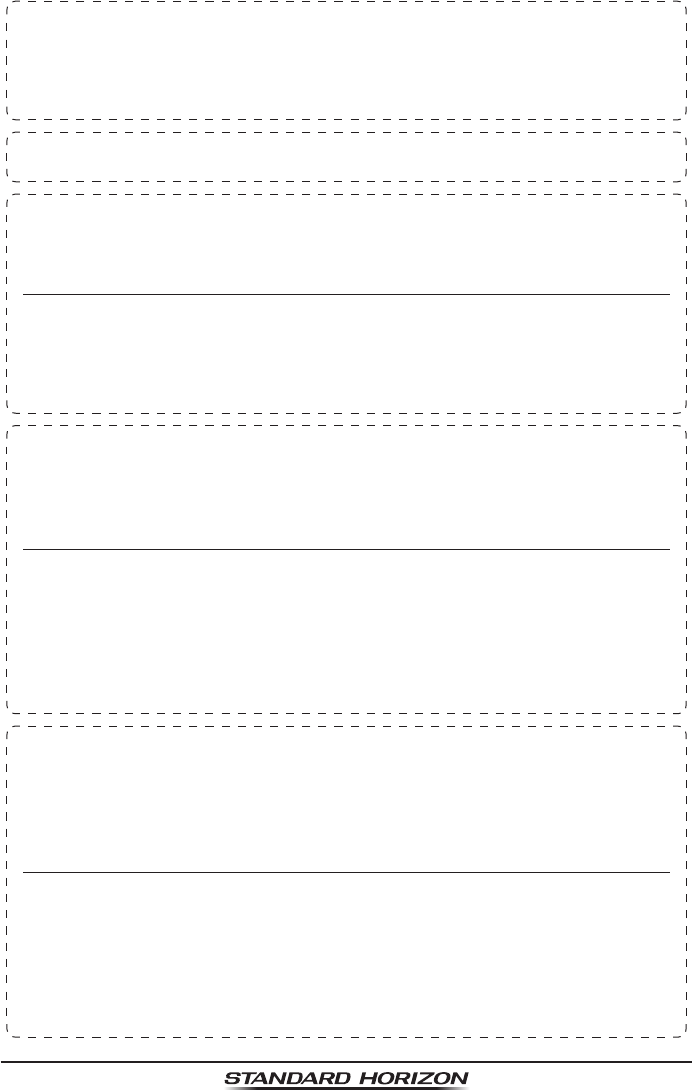
Page 43HX380
THIS DEVICE COMPLIES WITH PART 15 OF THE FCC RULES. OPERATION IS
SUBJECT TO THE FOLLOWING TWO CONDITIONS: (1) THIS DEVICE MAY NOT
CAUSE HARMFUL INTERFERENCE, AND (2) THIS DEVICE MUST ACCEPT ANY
INTERFERENCE RECEIVED, INCLUDING INTERFERENCE THAT MAY CAUSE
UNDESIRED OPERATION.
Changes or modications to this device not expressly approved by YAESU U.S.A.
could void the User’s authorization to operate this device.
This device complies with Industry Canada license-exempt RSS standard(s).
Operation is subject to the following two conditions: (1) this device may not cause
interference, and (2) this device must accept any interference, including interference
that may cause undesired operation of the device.
Le présent appareil est conforme aux CNR d’Industrie Canada applicables aux
appareils radio exempts de licence. L’exploitation est autorisée aux deux conditions
suivantes : (1) l’appareil ne doit pas produire de brouillage, et (2) l’utilisateur de
l’appareil doit accepter tout brouillage radioélectrique subi, même si le brouillage
est susceptible d’en compromettre le fonctionnement.
Under Industry Canada regulations, this radio transmitter may only operate using
an antenna of a type and maximum (or lesser) gain approved for the transmitter by
Industry Canada. To reduce potential radio interference to other users, the antenna
type and its gain should be so chosen that the equivalent isotropically radiated power
(e.i.r.p.) is not more than that necessary for successful communication.
Conformément à la réglementation d’Industrie Canada, le présent émetteur radio
peut fonctionner avec une antenne d’un type et d’un gain maximal (ou inférieur)
approuvé pour l’émetteur par Industrie Canada. Dans le but de réduire les risques
de brouillage radioélectrique à l’intention des autres utilisateurs, il faut choisir le
type d’antenne et son gain de sorte que la puissance isotrope rayonnée quivalente
(p.i.r.e.) ne dépassepas l’intensité nécessaire à l’établissement d’une communication
satisfaisante.
This radio transmitter (identify the device by certication number, or model number
if Category II) has been approved by Industry Canada to operate with the antenna
types listed below with the maximum permissible gain and required antenna
impedance for each antenna type indicated. Antenna types not included in this list,
having a gain greater than the maximum gain indicated for that type, are strictly
prohibited for use with this device.
Le présent émetteur radio (identier le dispositif par son numéro de certication ou
son numéro de modèle s’il fait partie du matériel de catégorie I) a été approuvé par
Industrie Canada pour fonctionner avec les types d’antenne énumérés ci-dessous
et ayant un gain admissible maximal et l’impédance requise pour chaque type
d’antenne. Les types d’antenne non inclus dans cette liste, ou dont le gain est
supérieur au gain maximal indiqué, sont strictement interdits pour l’exploitation de
l’émetteur. l’établissement d’une communication satisfaisante.
Application for FCC/IC
FCC ID: K6630393X20
IC: 511B-30393X20
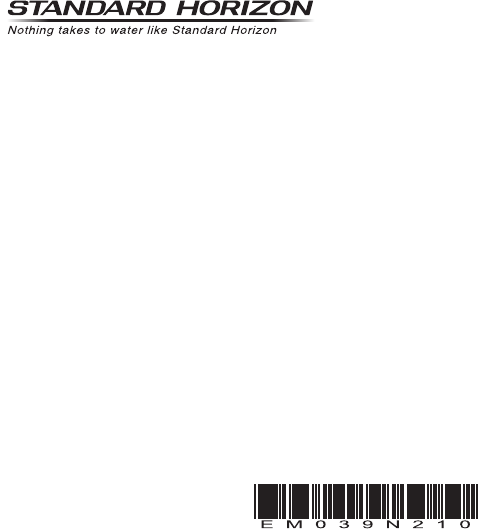
YAESU USA
6125 Phyllis Drive, Cypress, CA 90630
1509-0O
Copyright 2015
YAESU MUSEN CO., LTD.
All rights reserved.
No portion of this manual may be
reproduced without the permission of
YAESU MUSEN CO., LTD. Printed in Japan
Application for FCC/IC
FCC ID: K6630393X20
IC: 511B-30393X20